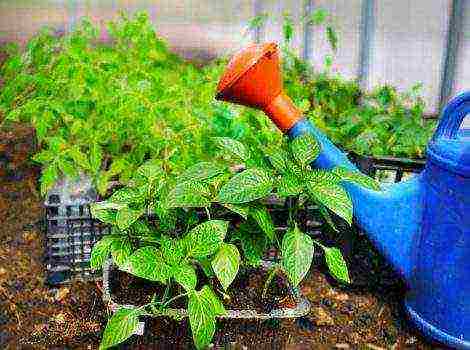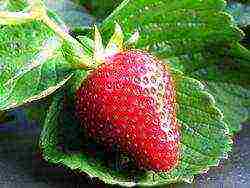Content
- 1 Crystal types
- 2 Ways to grow crystals at home
- 3 Preservation of crystals
- 4 What crystal can be grown from
- 5 How to grow a crystal of table salt
- 6 How to grow a sugar crystal
- 7 How to grow a copper sulfate crystal
- 8 Safety engineering
- 9 How to grow a crystal
- 10 How to grow a salt crystal
- 11 How to grow a copper sulfate crystal
- 12 Crystals use
- 13 Types of chemicals
- 14 Safety regulations
- 15 Salt crystals at home
- 16 How to grow a crystal from sugar?
Growing a real crystal is quite simple, interesting and educational. This article talks about how to do it at home.
Crystals are formed from any substance whose atoms and molecules are grouped into an ordered structure. You don't need a laboratory or special equipment to grow them. The simplest reagents that are always at hand will do.

Crystal growing is one of the easiest and safest chemical experiments available at home. Even a child of primary school age under the supervision of adults can carry it out.
The reward for your efforts will be an object of extraordinary beauty that you create with your own hands.
Crystal types
- A monocrystal is a one-piece large crystal, such as an artificial stone. It is formed under the condition that the crystallization processes are extremely slow.
- A polycrystal is formed when crystallization is rapid. In this case, many tiny crystals are formed. This is how metals behave.
Ways to grow crystals at home
One of the easiest ways to grow a crystal is to cool a saturated solution. What are the processes taking place at the same time?
- In warm water, the substance chosen for the experiment (for example, salt) dissolves completely.
- The temperature of the solution is lowered: this reduces the solubility of the salt. An undissolved salt is formed which precipitates.
- Sediment formation begins with the formation of small grains both in the solution itself and on the surface of the container in which it is placed.
- If there are no foreign inclusions in the solution (ordinary dust grains, villi, etc.), and cooling occurs gradually, these grains-crystals grow together into larger and more regular crystals.
- Rapid cooling causes the formation of many tiny crystals of irregular shape at once, which do not connect to each other and inhibit the growth of each other.
The crystal will also grow if the solvent (water) is gradually removed from the saturated solution. How to do this and what will happen in the vessel?
- Cookware with a saturated solution must be kept at a constant temperature for a long time.
- It is necessary to exclude the ingress of litter and dust, and also to slow down the evaporation of water (for this, it is enough to cover the container with paper).
- The crystal can be grown on some kind of suspension in the middle of the container (then it will acquire the correct shape), or at the bottom of the container.
- If the crystal grows at the bottom, it must be rotated periodically to achieve symmetry.
- In place of the evaporated water, add a solution of the same consistency as at the beginning of the experiment.
The basic principle in this case remains the same: the slower the processes affecting crystallization, the more beautiful, larger and more correct the crystals will be.If the original crystal, which served as the basis for growing, had an irregular shape, it will supplement the missing parts during growth and assume a configuration typical of the nature of its substance. So copper sulfate will eventually grow into a rhombus, and the salts of potassium chromium alum will form an octahedron.
It is believed that only a small crystal can grow at home from improvised means. This is not so: with due care, there is every chance to grow a crystal of any size and weight at home. In fact, for this it is enough to continue the crystallization procedure until the desired result is achieved. Of course, it is necessary to immediately select a container of a suitable size.
Preservation of crystals
Failure to comply with storage conditions can lead to destruction of the crystal. It is necessary to familiarize yourself with the characteristics of the selected substance in advance in order to avoid disappointment at the end of such a long and painstaking work.
Thus, the chiseled edges of the alum crystal under the influence of ordinary dry air will tarnish due to the loss of moisture and crumble, forming a gray powder. The same will happen with sodium sulfate and thiosulfate, salts of manganese, zinc, nickel, Rochelle salt. The only way out is to place the crystals in sealed transparent vessels. Some recommend covering the crystals with a clear varnish, but this only delays the time of death. And also - the lacquered edges lose their original shine and look artificial.
The high temperature destroys crystals grown from copper sulfate and potassium alum. The life of such crystals can be extended by storage in a household refrigerator. However, even here they will hold out for about 2 years.
Another problem of crystals of water-soluble substances is that they are destroyed by temperature changes due to moisture, which is retained in a small amount inside them. For this reason, spots and chips appear, the edges are sagging, and the gloss is lost.
Perhaps the most stable of the substances popular for growing crystals is table salt.
What crystal can be grown from
In addition to the above substances, crystals at home can be grown from sugar.
It is much more difficult, but at the same time more interesting, to grow artificial stones (amethysts, quartzites, rubies, etc.). This is a rather laborious process that requires special equipment to maintain constant temperature, pressure, humidity and other parameters important for the success of the experiment. In other words, to get an artificial stone, you need a real laboratory.
What should be the substance for growing a crystal at home?
- Safe, non-toxic. Not all substances with a crystalline structure meet this requirement. For example, potassium cyanide KCN (or sodium sulfide Na2S) also forms crystals of its characteristic shape. But it is impossible to carry out experiments with it at home, because it enters into an oxidation reaction with oxygen in the air and releases toxic substances that are dangerous to humans.
- The second important quality is stability. That is, the selected substance must enter into a reversible reaction with water. In addition, resistance to temperature fluctuations is important. Some organic matter can be irreversibly destroyed when it gets into hot water (hydrolysis reaction).
- The cost of reagents. As you know, the first experiment (or several) may not be very successful, therefore, for a start, it is better to opt for inexpensive and affordable substances.
- Yes, growing crystals will need a lot of purified water - this should also be taken care of in advance.
- The ability to dissolve in water. Before starting the experiment, you should find out what consumption of the selected substance for a given volume of water will be required. To grow a sugar crystal, for example, you need to dissolve at least 2 kg of sugar in 1 liter of water. So it is better to first draw up a graph of the solubility of the starting material.To do this, subtract the mass of the same volume of the filtered solution from the mass of a glass of water after the dissolution is over and the temperature stabilizes. This will help you get an idea of how much substance is needed for crystallization for a given volume of water.
How to grow a crystal of table salt
The easiest way to practice is with regular table salt. Then you will not need special chemical reagents, only salt and purified water.
Step 1. Prepare a crystal of salt by tying it with a thin thread fixed in the middle of a small stick (pencil, pen).
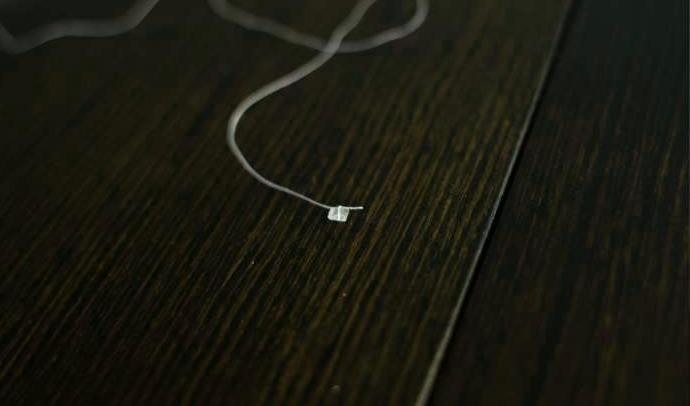 Salt crystal
Salt crystal
Purpose: to place the crystal so that it is immersed in the solution, but does not come into contact with the surface of the vessel.
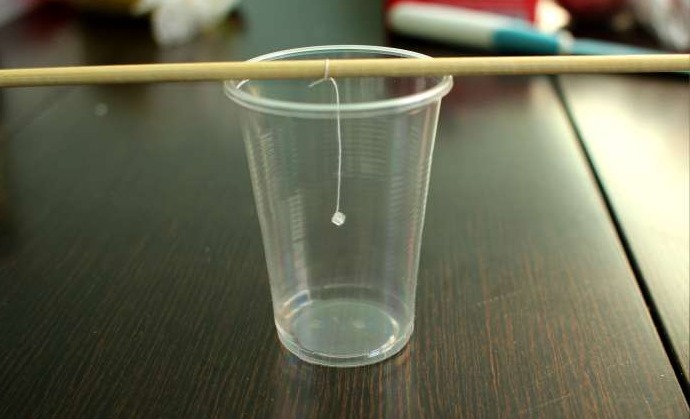 Tie a crystal of salt to a thread and place it in a glass
Tie a crystal of salt to a thread and place it in a glass
Step 2. Pour warm water into a container (transparent so that you can observe the growth of the crystal) and add salt. Stir until the salt is completely dissolved. Then add salt and repeat. It is necessary to salt the water until the salt stops dissolving. This is noticeable by the appearance of sediment at the bottom of the vessel.
Step 3. The solution should be gradually heated by placing it in a container with a larger diameter with hot water. As a result, the precipitate will dissolve. If there is something left at the bottom, it is better to pour the solution into a clean container.
Step 4. Place the container with the resulting solution in a place with a stable temperature. Immerse a crystal-nucleus on a thread into the solution. From above, the vessel with the solution must be covered with paper.
 We immerse the crystal-germ on a thread in a solution
We immerse the crystal-germ on a thread in a solution
Step 5. The crystallization process has started. Then, when the water evaporates, it will be necessary to add a solution of the same salt content to the container as it was at the beginning of the experiment. After a while, it will become noticeable that the original crystal has increased in size. You can grow it as much as you like, as long as the size of the container and patience are enough. The resulting crystal will be fairly durable.
How to grow a sugar crystal
Sugar crystals can be used as table decoration or candy canes for children. But they are quite expensive due to the high consumption of sugar. For 2 glasses of water, you will eventually need 5 glasses of granulated sugar.
 Sugar crystals
Sugar crystals
The process for preparing the solution is similar to how it is done for salt crystals. It is most convenient to grow sugar crystals with toothpicks or wooden skewers. To "seed" it is enough to dip a skewer in syrup and dip in sugar so that it adheres evenly to the surface. You need to wait a while for the sugar to stick well and dry.
To form colored crystals, it is worth adding food coloring to the syrup (the best option is juices).
It will take 1 week to grow a sugar crystal from the specified amount of ingredients.
Sugar crystals on sticks (Video)
This video shows you how to grow edible crystals from sugar that are not only beautiful to look at, but also delicious.
How to grow a copper sulfate crystal
Salt crystals are transparent white, while copper sulfate gives a rich blue hue.
 Copper sulfate crystal
Copper sulfate crystal
Growing such a crystal is no more difficult than growing a salt one: you need a saturated solution and a crystal-nucleus on a thread.
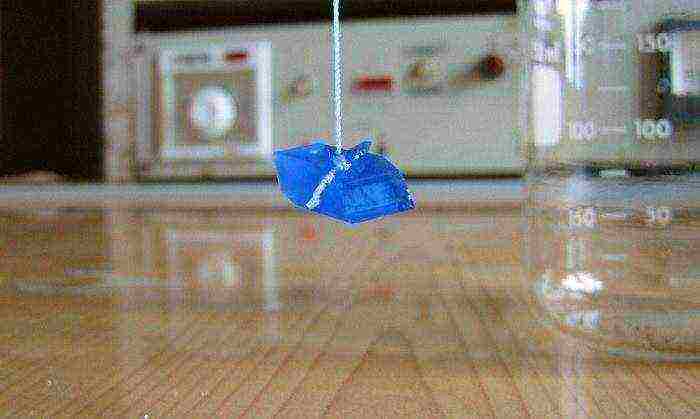 Copper sulfate crystal suspended on a string
Copper sulfate crystal suspended on a string
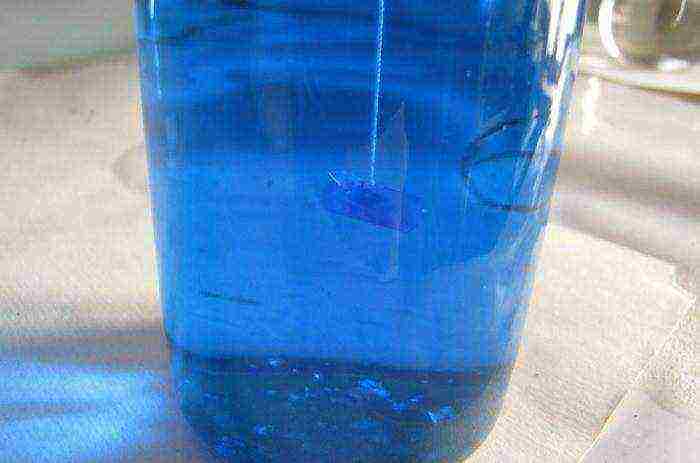 In a saturated solution of copper sulfate on a thread, lower the seed
In a saturated solution of copper sulfate on a thread, lower the seed
The solution in a transparent container should be placed in a shaded place with a stable temperature, the crystal should be suspended in the same way as in the case of salt, and wait, periodically adding the solution instead of the evaporated one.
 Day 42 of the experiment
Day 42 of the experiment
The crystal must not be removed from the working solution until the procedure for its formation is completed!
Safety engineering
You cannot use food utensils to grow crystals (with the exception of experiments with salt and sugar).You should not leave food nearby: firstly, because the reagents are toxic, and secondly, because of litter and crumbs, which, if they get into the solution, will ruin the experiment.
When handling chemical reagents, absolutely all the rules indicated on the package should be observed. At the end of the work, you need to wash your hands.
Growing a crystal at home is quite simple, interesting and informative. It is best to practice with the available substances first. If something goes wrong, you need to verify that all the conditions necessary for the formation of a crystal are met. Having mastered the simplest crystals, you can start working with other reagents. It never gets boring, because different substances give crystals of different shapes and colors. In addition, there are no two absolutely identical crystals, and their configuration and size can be adjusted at will.
Sugar crystals are grown for one week. They are added to tea, served as a sweet snack and decorate desserts. Let's prepare crystals on a wooden stick.
You will need:
- sugar - 5 glasses;
- water - 2 glasses;
- wooden sticks;
- paper;
- glasses or jars.
If you want the crystals to be colored, use food coloring.
From 50 ml of water and 2 tbsp. l. sugar, boil the syrup. Sprinkle sugar on a flat surface. Dip wooden sticks in syrup, and then roll in sugar. Leave to dry overnight.
Boil the remaining water and add sugar gradually. Stir until completely dissolved. Boil the syrup and leave on the stove for 10-15 minutes. Make holes in the paper. Pour the hot syrup into transparent glasses or jars. Stick the sticks into the paper and immerse them in the solution so that it covers the glass and holds the blanks. After 7 days the crystals will grow.
Use edible salt for growing. The time of the chemical process is 1–1.5 weeks.
You will need:
- water - 500 ml;
- salt - 4-5 tbsp. l .;
- glasses - 2 pcs;
- rope;
- filter;
- holder.
Use a pencil, clothespins or cardboard as a holder.
Pour salt into hot water and stir. Filter undissolved crystals through cheesecloth. Take a large crystal of salt (seed). Tie it with the edge of a piece of string or line and place it in a saline solution. Attach the other end of the thread to the holder. Make sure that the seed does not touch the bottom and sides of the glass. Leave the solution in a warm place.
This recipe is suitable for growing copper sulfate crystals. The substance is sold in stores for summer residents. Pour the vitriol with water up to 80 degrees, otherwise it will not dissolve. You will find the blank in the bag with the substance. Or prepare it yourself. Leave the solution to cool, and after 30-60 minutes formations will appear on the bottom. Also tie the seed with a thread and immerse it in the solution for 1-2 weeks.
In addition to sugar, salt and copper sulfate, crystals are formed from citric acid, potassium alum, copper, ferrous sulfate and potassium chloride. For instructions on how to work with the last substance, see the video below.
(
votes, average rating:
out of 5)
Man strives to be on a par with nature in everything. Today he can do a lot. Surrogacy, nanotechnology, let alone artificial reconstruction of the structure of minerals. And not in some super-powerful laboratory, but at home, one might say, on the kitchen table. Yes, yes, today anyone can find out how to grow a crystal, and even easily deal with it.
How to grow a crystal
At this word, each of us imagines transparent, large, colorless or bright polyhedrons with shiny perfect edges. They owe their exceptional qualities to their structure: crystals and amorphous bodies are distinguished by the existence of a strict crystalline lattice in the internal structure of the first.If we imagine that a person has shrunk a million times and ended up inside a glass cube, then around him he would see a disorderly heap of various molecules. But if you look inside even the smallest crystal, you can see a completely different picture: on different sides, rigidly ordered ranks of molecules, ions or atoms, which obey the laws of strict symmetry, rule in the world of regular crystals, endlessly.
To realize how common substances with a crystalline structure are in the surrounding nature, you just need to remember that most rocks are composed of crystals. But the entire crust of the Earth is built precisely from rocks.
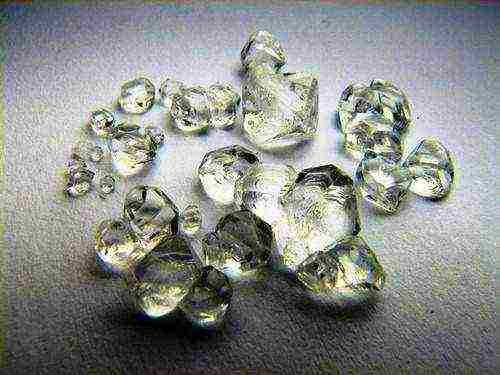
Growing crystals is a very exciting business, and if you do it with children, it is also educational.
And although in creating crystals at home we are able to equalize with nature, but first, perhaps, it would be worthwhile to familiarize ourselves with the rules for growing a crystal from a solution.
Before learning about how to grow a crystal at home, it is important to remember the basic safety rules when experimenting with toxic salts:
- it is impossible to use food utensils during the experiment, since its subsequent use during a meal can provoke poisoning of the body;
- you can not eat food at the same time as the experiments, which can also cause poisoning;
- it is impossible to use unknown reagents for experiments;
- All chemicals should be stored in sealed containers in a dry, safe place out of the reach of small children and animals. On it you need to make an inscription that will inform you about the content;
- during the experiments, you must use gloves and protective clothing;
- experiments accompanied by even the smallest release of harmful compounds should be carried out in laboratory fume hoods;
- in case of contact of the solution on the skin, immediately rinse this area with clean running water. If acid gets on the skin, then you need to treat the body with a weak alkali solution. Well, and vice versa: when alkali gets on the skin, the site of the lesion is treated with a weakly acidic solution. If the solution gets on the mucous membranes or in the eyes, then you should urgently go to the hospital, and before that, rinse them with water.
How to grow a crystal from sugar
After such instruction, you can start working on growing crystalline substances using even the most aggressive components. But the best place to start is with ingredients that are absolutely accessible, safe, and even enjoyable. The most popular experience is how to grow a crystal from sugar.
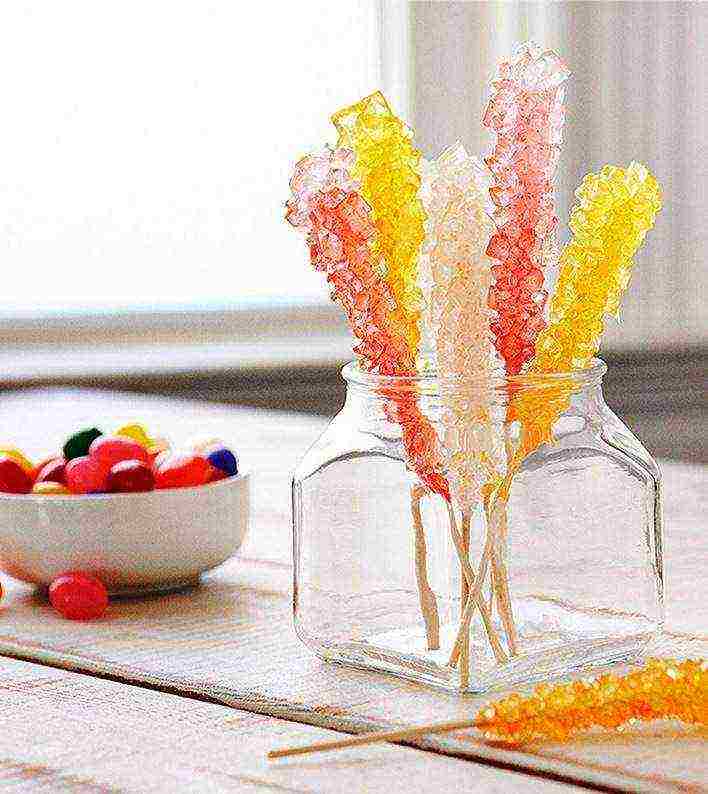
Sugar skewers are very fond of children.
Such crystals are often attached to expensive teas and look very tasty and beautiful. So much so that you don't even want to stir tea with them - it's a pity! In addition, this stick alone costs about 160 rubles: you must admit, it's very expensive. But you can grow them yourself much cheaper. So, for one sugar crystal on a stick you will need:
- water - two glasses;
- sugar - five glasses;
- wooden skewers or sticks for mini-kebabs;
- thin paper;
- pan;
- transparent cups;
- food coloring if you want to grow a multi-colored crystal.

Once you've prepared the sweet solution, start making skewers. Tie two twigs together. The first will serve as a "fishing rod", and the second - as a mount.
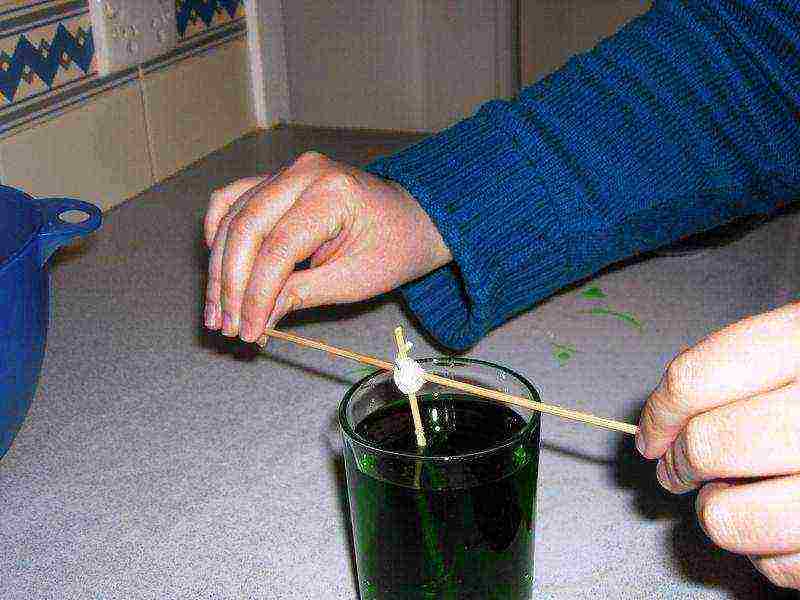
Place the sticks (or toothpicks) in the syrup and wait.

For that,. it takes a week for the sugar crystal to grow.
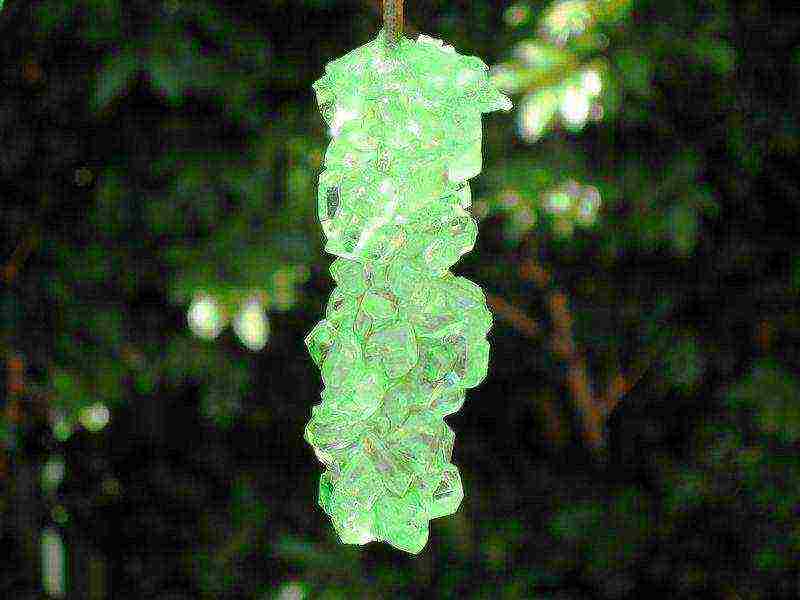
After the seven-day period, enjoy the sweet treat.
It all starts with taking a quarter of a glass of drinking water and a couple of tablespoons of granulated sugar. On the fire, the sugar is brought to dissolve and get a syrup. Then a little sugar is scattered on a piece of paper, the stick is dipped in syrup and rolled in sugar.It is necessary to make sure that its cubes adhere evenly on all sides of the stick, which will make the crystal even. Then several similar sticks are prepared, which are left until they are completely dry, so that the saccharins do not crumble when they get into the hot syrup. After all, if this happens, then subsequently the crystal will have nothing to cling to and it will not be able to grow. Therefore, it is better to prepare the sticks ahead of time, for example, in the evening, and leave them to dry throughout the night. Then a saucepan is taken, water is poured into it - two glasses, and sugar is poured out - two and a half glasses.

Clothespins can be used as fasteners.
The syrup is put on a small fire and, with constant stirring, all the sugar dissolves. The remaining sugar is poured into the resulting syrup - two and a half glasses, and cooked until it is completely dissolved. After turning off the heat, the syrup is left on the stove for another 20 minutes. While it cools, sticks are being prepared. Papers are taken and pierced with a skewer. You don't need to make the hole very wide, because the point is for this piece of paper to sit tightly on the skewer.
Then hot syrup is poured into glasses. It is necessary that it is the hot syrup that is poured, because otherwise the crystals will not grow. If you want to know a way to grow a crystal at home, and even a colored one, then everything is simple: a little food coloring is added to the syrup. The workpiece is lowered into the glass, but so that the sugar does not touch its walls and bottom. And the piece of paper in this case is both a holder for a stick and a lid for a cup, which protects the syrup from dust. The same procedure is done with all the remaining blanks: they are placed in glasses and left to grow for about 7 days.
Children will watch this process with interest, as the crystal will grow every day. But we must be prepared for the fact that they all grow in different ways: some quickly, while others will need a much longer period of time. But when after a week there are no changes, you will have to repeat all over again. Most often, beautiful crystals grow in just a week. A few unprepared ones can be left to ripen for the same time. Well, and arrange a delicious tea party! True, such a sugar crystal can simply be sucked like a lollipop.
How to grow a salt crystal
One of the easiest ways how to grow a salt crystal at home, will require its performers not only to be smart with the solution, but also to stock up on remarkable patience. So:
For work you will need:
- drinking water
- small saucepan
- transparent glass container (the best option is a jar)
- a pack of table salt
- silk thread.
Water is poured into a saucepan and put on fire, but it is not brought to a boil: the solution should turn out to be hot, but not boiling water. After heating the pan with water, salt is poured into it in small portions, while the solution must be constantly stirred. A new portion of salt is added when the previous one has already completely dissolved. The concentration of the solution should be such that the grains of salt cease to dissolve in it. For the role of the starter, the largest of the crystals from the already completely settled saline solution is selected.
The concentrate can now be considered ready. It should be poured into a glass jar and allowed to stand for about a day. This must be done so that small, undissolved salt particles fall to the bottom. On the second day, many small crystals can be seen in the jar. You need to choose the largest of them and get it, and then tie the crystal on a thread or attach it to a wire. This will create a seed, the presence of which is important before how to grow a crystal of table salt... Then the solution must be poured into an empty container, but so that small crystals do not fall. When this is not done, the salt crystal particles will begin to take the substance out of the solution for their growth.
Then the seed is dipped into a solution poured separately, and you should be patient. But while the crystal is forming, there are some important tips to learn about growing it. With rapid cooling of the saline solution, the crystal grows in a minimum time, but its shape will be geometrically irregular, but crystals grown with a gradual decrease in temperature will take more time, but will amaze with their perfect beauty. You should also not shake the jar with the growing crystal, just as you should not take it out until the process, in your opinion, is finally completed.
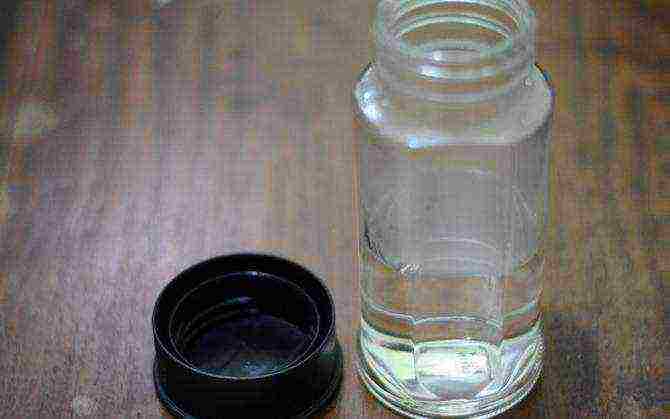
Boil water and pour immediately into the jar.

Add 2-3 tablespoons of salt to the mixture and stir with a spoon until even fine particles dissolve.

Add the rest of the salt and mix thoroughly.

You now have a saturated solution ready.
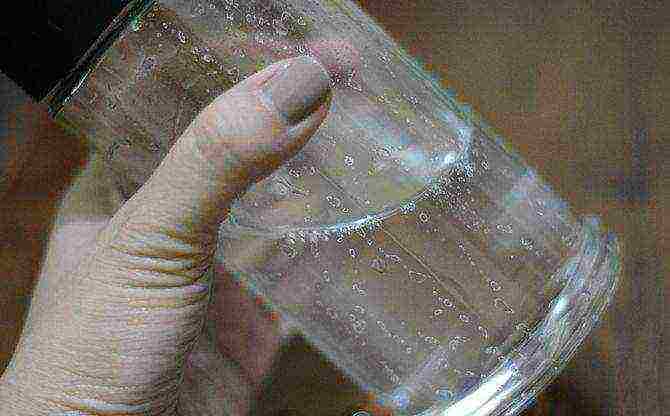
Shake the jar well.

Tie a string around a pencil or stick.
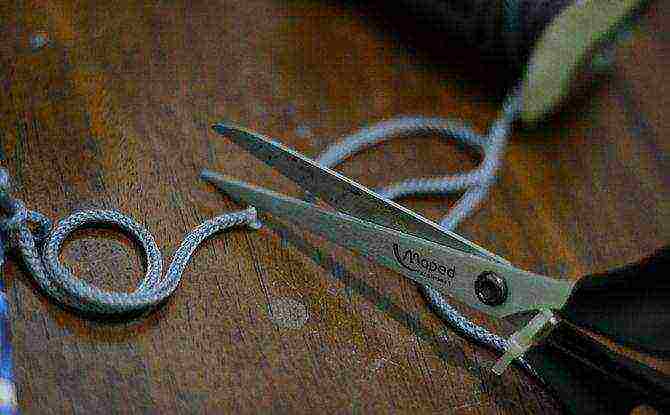
Cut off the excess length so that the lace does not touch the bottom of the jar.
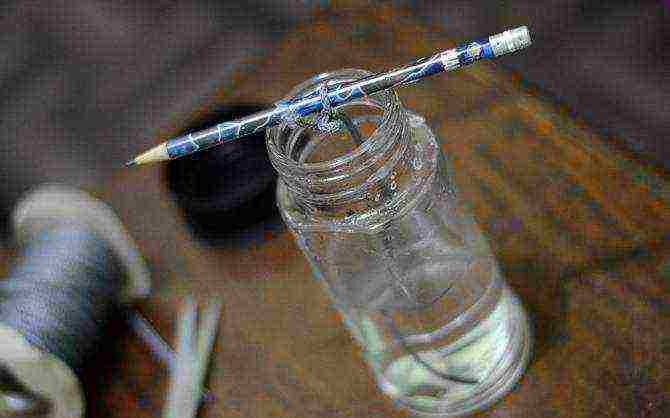
Lower the end of the rope into the jar.

Leave the jar in a warm, sunny place for 1-3 weeks. Check the lace regularly, it will gradually become covered with white crystals.
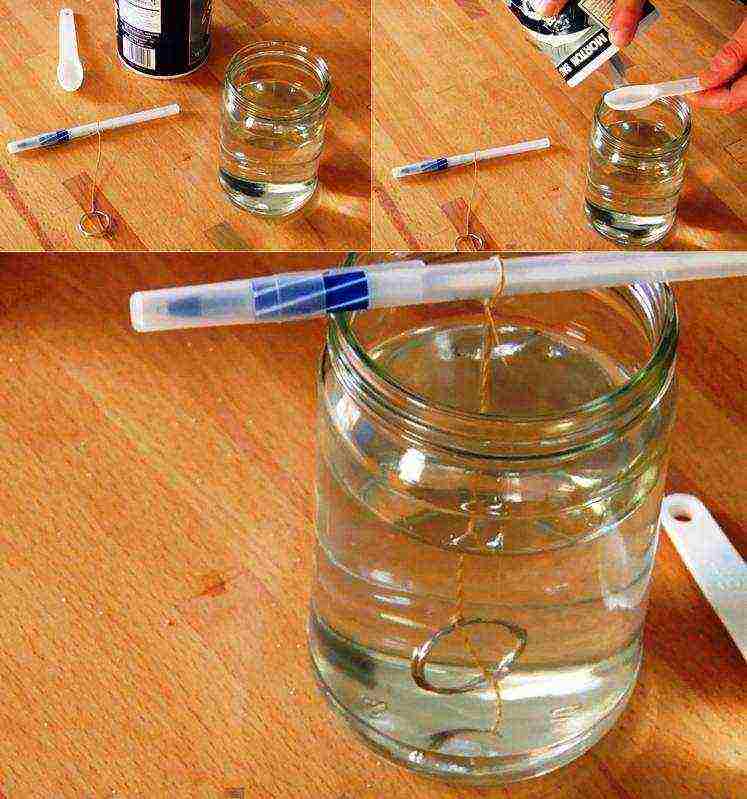
Instead of a rope, you can use an iron ring, then the crystals will grow in a circle.
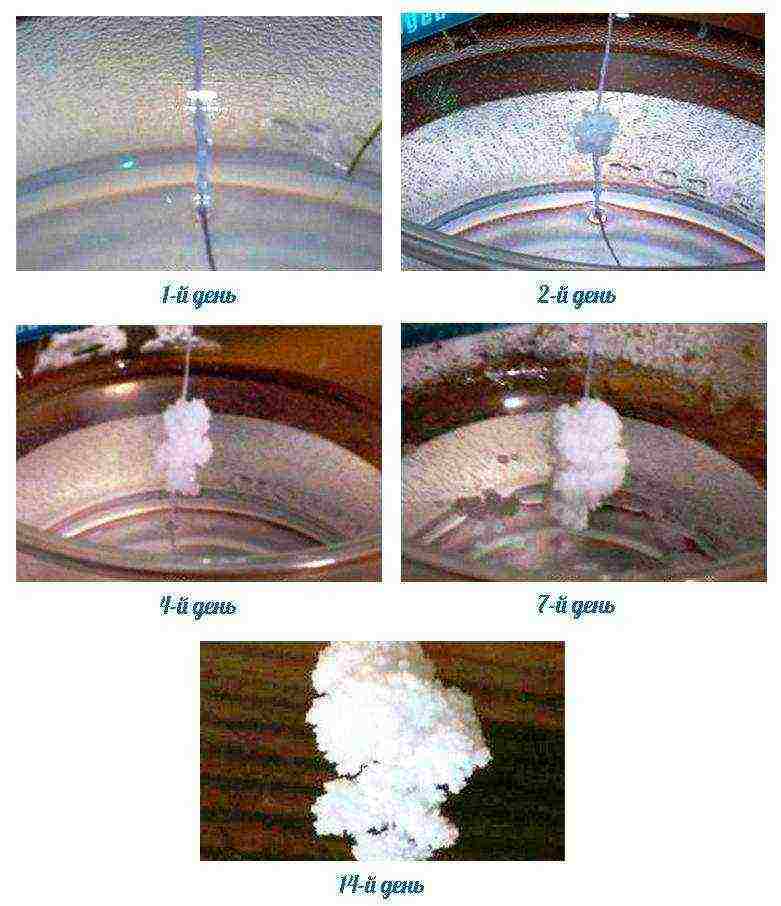
These figures clearly show how the crystals grow.

So the thread with crystals will change over time. On average, it will take 2-3 weeks to grow a crystal.
Very beautiful crystals do not grow from ordinary salt, but from alum. Alum is a double salt and can be bought at any pharmacy, as it is a drug that is used as a hemostatic and cauterizing agent. They are cheap - about 12 rubles. Now we will demonstrate a master class on growing crystals from alum. They turn out to be very regular and beautiful in shape and grow faster than crystals from salt.
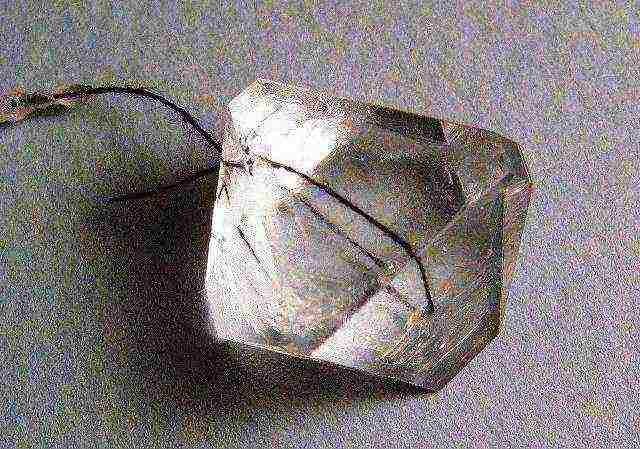
As you can see, this crystal is the correct shape compared to the common salt crystal.

Aluminum sulphate costs from 8 rubles and is sold in a pharmacy. It is often used as a styptic, such as when you cut yourself while shaving.
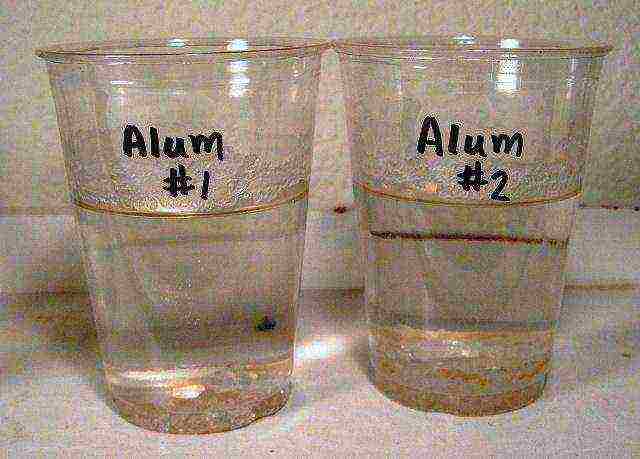
For the experiment, it is better to use two glasses so that there is a selection of good crystals. Bring half a liter of water to a boil and dissolve six tablespoons of alum in it. Leave the cups for a week.

This is how alum crystals grow during the week.
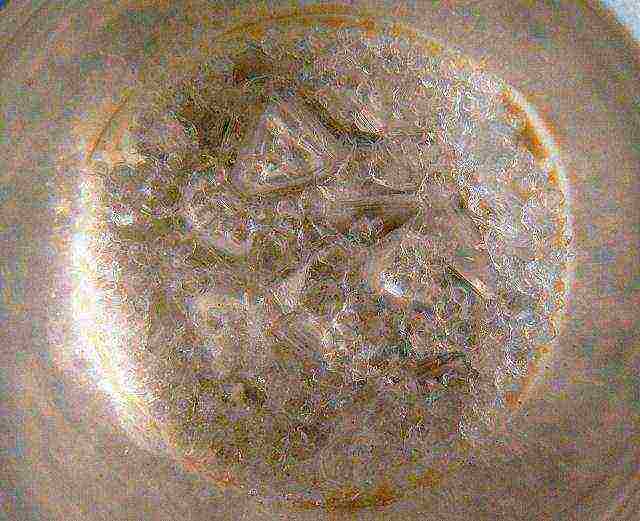
There are too many small alum in the second glass, which is why we immediately decided to grow crystals in two glasses, and not in one.

Select crystals of the correct shape and size and place them on a paper towel.

This is how one big crystal of irregular shape grew. If you do not want to grow such an awkward crystal, saw off a large part from it.

The separated part of the crystal. We will continue to grow it.
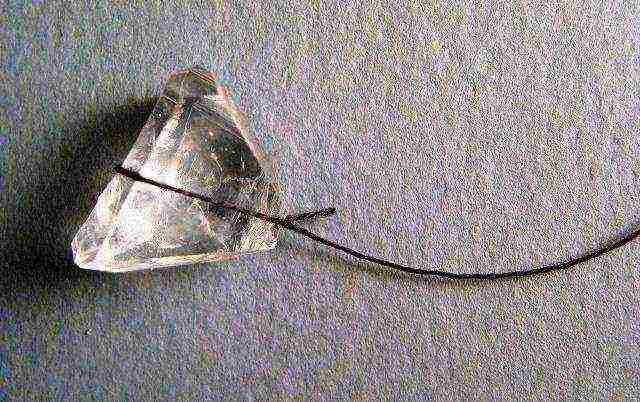
Tie the crystal to the string.
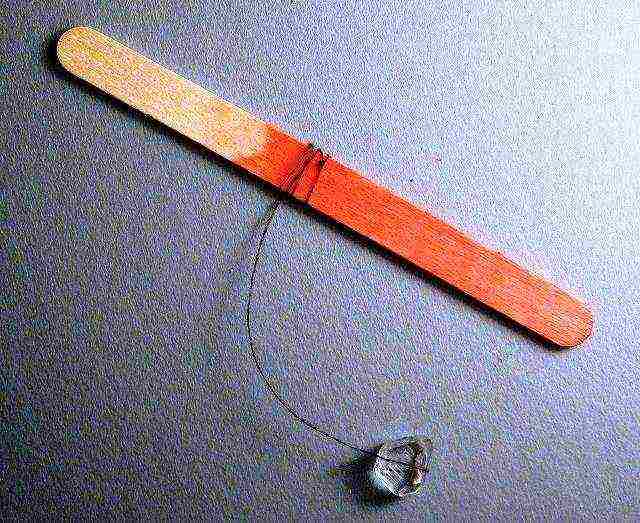
It is very convenient to use an ice cream stick, it will not slip or fall, unlike a wooden pencil.

Place the crystal in the alum solution, it is also prepared, only the ingredients can be halved (a glass of water, 3 tablespoons of alum)

After a week, our crystal has grown significantly.
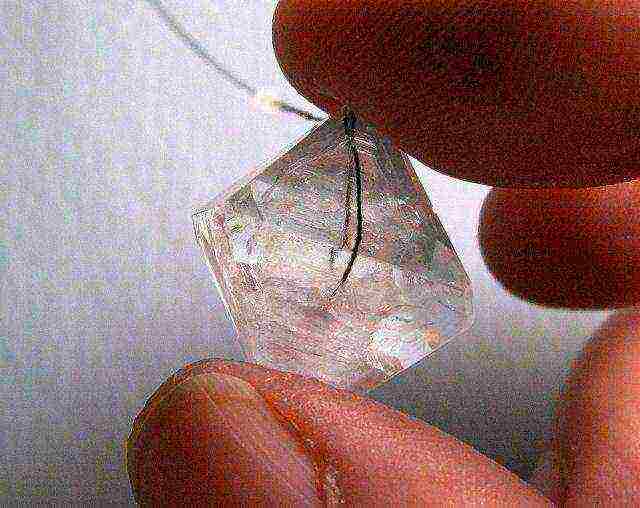
The crystal has the shape of an octahedron. Remember, the crystal does not change shape as it grows, whichever form you choose the seed crystal will continue to grow.
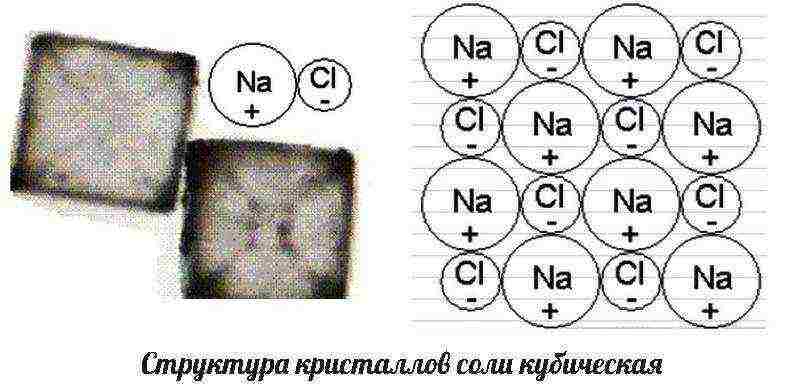
The structure of the salt crystals is cubic, so all crystals are in the form of cubes, in contrast to alum crystals, which can have a variety of shapes.
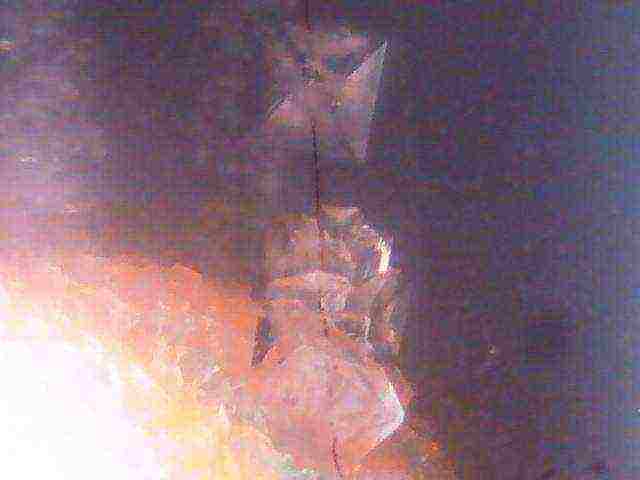
The photo shows how crystals of salt gradually grow.
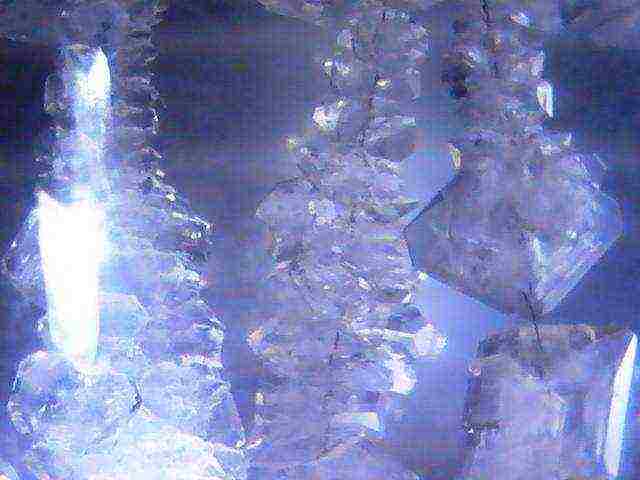
Crystals can grow more intensively or slower depending on the saturation of the solution.
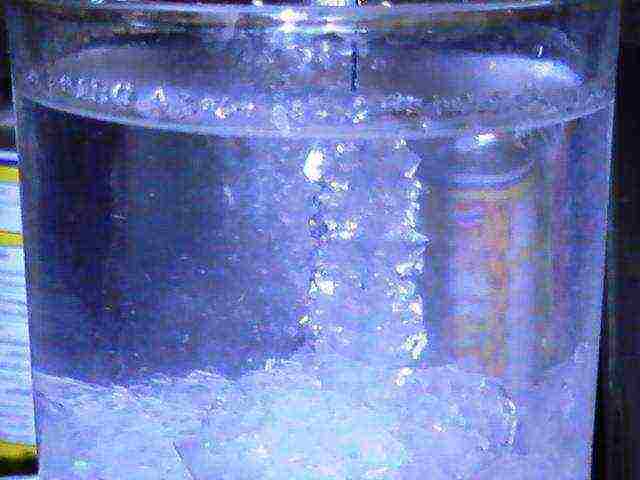
This crystal is about 2 weeks old.
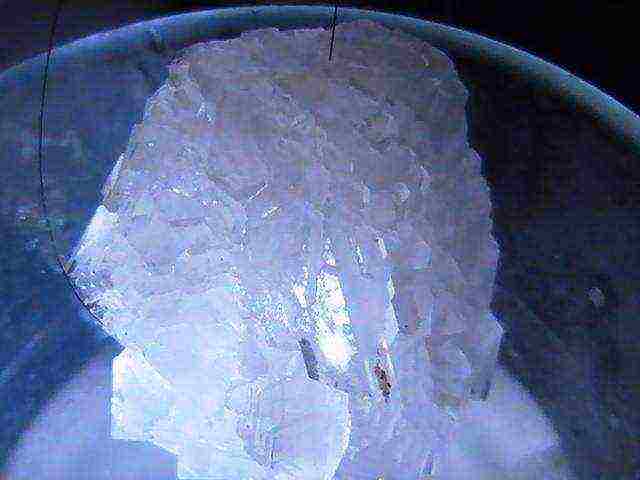
And this crystal grew for at least 3 weeks.
If you want to conduct an interesting experiment with a child, choose bright materials and a saturated solution, so the crystal will be more noticeable and interesting to the baby.

Such a crystal can be grown on a lace or fluffy Christmas tree tinsel.

Make a solution and place a string in it.

In a week, natural processes will do their job and transparent "icicles" will appear on the string.

Salt grows in regular cubes or parallelepipeds.
How to grow a copper sulfate crystal
For the most avid alchemists, salt and sugar alone are not enough. In addition, they are interested in, for example, how to grow a crystal of copper sulfate... But the technique below is suitable for growing absolutely all types of crystals.
To grow a large enough crystal from an aqueous solution of copper sulfate, you will need:
- a glass or plastic container of any size, but it is better to be transparent and colorless, so that one can easily spy on the growth of crystals in it. The plastic version is convenient in that crystals do not grow to it. If the jar is larger, then this will allow you to grow a crystal of much larger size. But it is also important to take into account that the larger the can, the more solution will have to be prepared and the larger portion of the reagent will be required;
- copper sulfate or copper sulfate, which can be bought not only in a chemical store, but also in a gardening store. Although it will not be clean enough, this is not so important. Before you buy salt, you need to consider the substance. To do this, the package contains a small strip of transparent polyethylene, through which a bright blue powder should be visible. In the presence of large lumps, especially green ones, it is better to refuse to buy, because such vitriol was probably stored at high humidity and is oversaturated with a huge amount of impurities. You will have to suffer with it when growing crystals, and therefore it is better to contact another similar store.

Growing crystals from copper sulfate is perhaps the most popular. They are beautiful in shape and grow quite quickly.

Copper sulphate is used in horticulture and agriculture as a means to combat fungus and mold. Copper sulfate is quite toxic, so in experiments it is recommended to use disposable or non-food utensils and wash hands thoroughly.

For the experiment, we need 100 grams. copper sulfate per 100 ml of water. Stock up on 300 ml of water and 300 gr. vitriol, respectively.

Put the jar in a water bath and pour hot water into it, dissolve 100 g in water. vitriol.

Transfer after 10 minutes. vitriol from the first can to the second. After a while, check the bottom of the can; seed crystals should form there.

Try to select crystals of the correct shape, 1-2 mm in length. Dry them on a paper towel, try not to touch them with your hands, use tweezers.
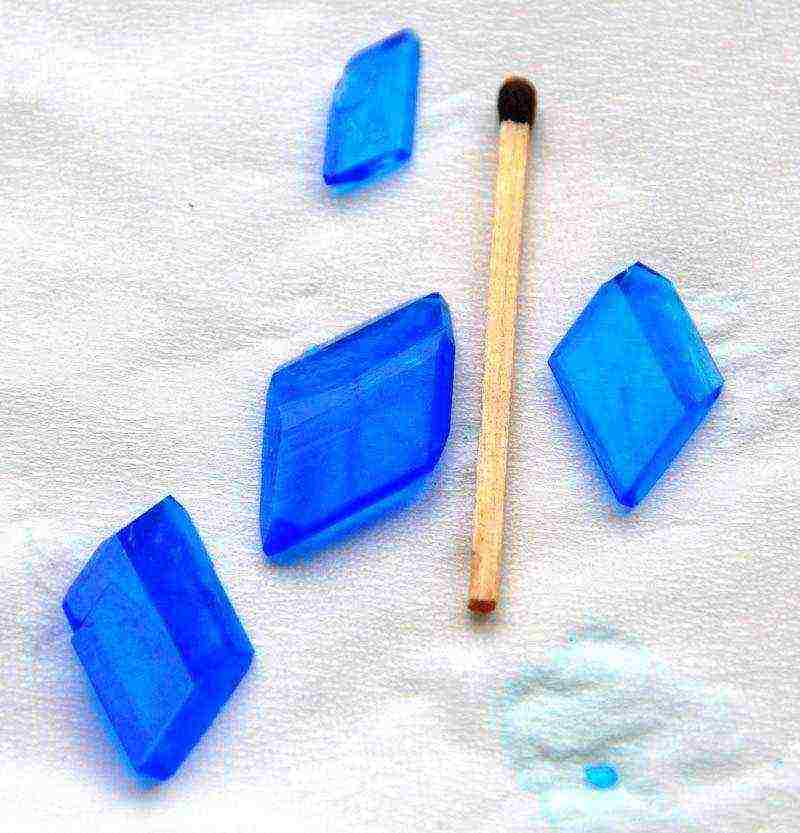
Prepare 200-300 ml of the solution and, tying the seed crystal with a thread, place it in the solution.
Having prepared in this way, there is nothing left but to grow a crystal from vitriol. So, a container is taken and copper sulfate is poured into it. You do not need to pour a lot, for a start, 100 grams will do. Salt is poured into hot water (better, of course, distilled, but not necessary). Then you can use two ways. First, a seed is taken, that is, a small crystal. The more there are, the more crystals will come out. A little water is poured, and the solution is constantly stirring. It should become so saturated that the salt grains at the bottom cannot dissolve. The solution is filtered while still hot and placed in a cold place, but not covered with a lid. On the second day, the bottom of the container is covered with a bunch of small crystals. It is necessary to select from them a couple of pieces of the smoothest and largest. You can also choose according to your taste - the ones that you like the most.A solution for crystals can be prepared in the same way, but add a little more water, cool, and then filter thoroughly.

Copper sulfate is a poisonous compound, but you can buy it at any garden store.

Crystals can be obtained from vitriol in two ways: cooling and evaporation, but most experimenters still prefer evaporation.

It takes 4-6 hours to grow a copper crystal.
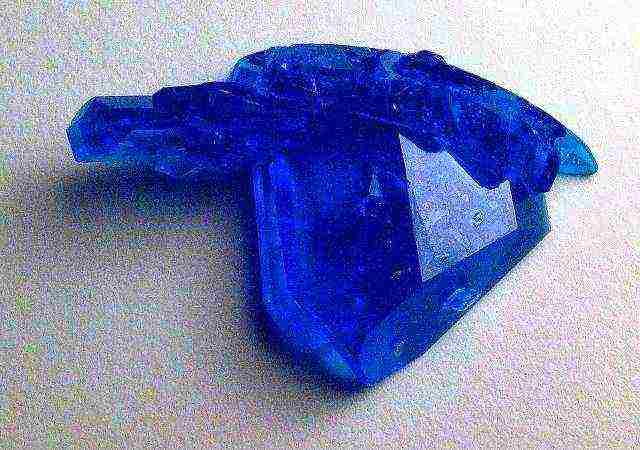
It should be noted that after a few hours the crystal will lose its luster, as the water will evaporate from it. To prevent this, cover the crystal with varnish. So it will not only remain shiny for a long time, but it will also become non-toxic and can be taken in hands without fear.
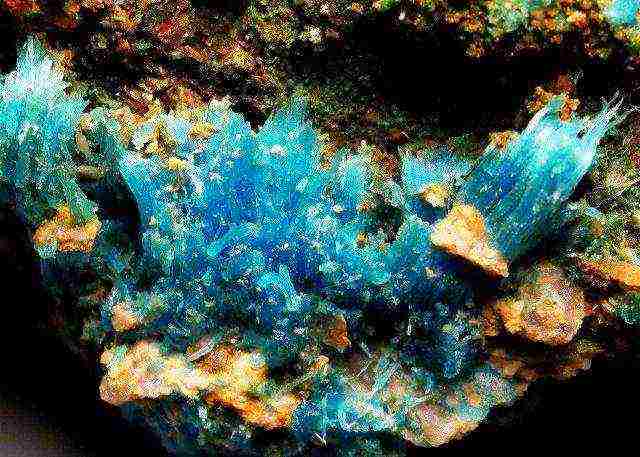
These wonderful crystals are the chalcanthite mineral. It is formed naturally from copper sulfate in nature.
When the solution and the seed are ready, you need to rinse the seed under running water, but you do not need to touch it with your hands, since copper sulfate is still a chemical substance, and fingerprints may remain on the seed, which will cause the crystal to acquire an irregular shape. Then the seed is carefully placed in a container with a filtered and cooled solution. It can be placed at the bottom, as a result of which the crystal will grow only in width and length. The best option would be to hang the seed on a line: when using a thread, many small crystals can grow on it, but this will not happen on a line. The other end of the line is tied to a pencil or similar long object, and then the crystal is placed in the solution. the length of the line should be adjusted so that the dummy line hangs on it in the middle of the solution itself. So the crystal should grow evenly in all directions. The container is placed in a place with a constant temperature and covered with a sheet of paper. And not cardboard, under which even small crystals will grow for several months, but under thin paper only a few weeks. Once a week, the solution should be filtered to remove the precipitated crystals. So beautiful crystals of bluish-blue color will grow, having edges in the form of a parallelogram. When their size is right for you, take them out, rinse them in running cold water, wipe them off with a napkin and open them with several coats of colorless varnish, and nail polish is also suitable. Such a crystal is freely taken in the hands, moistened with water, which does not harm it in any way, because the varnish will completely protect the fragile substance. But you should not treat them less carefully because of this, so as not to inadvertently destroy the beauty. Do you also want to become a magician and try to grow such a wonderful crystal with your own hands? Then do not waste time, because you will need it to create an ordinary miracle!
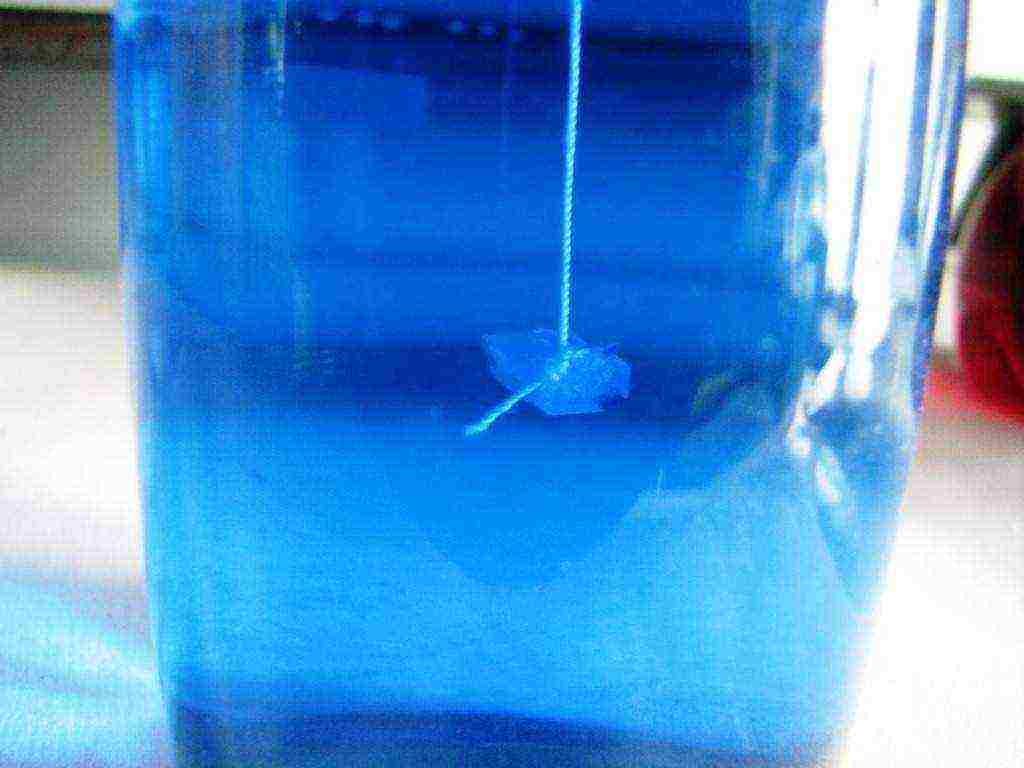
This is how the growth of a crystal of copper sulfate looks like. The first day.
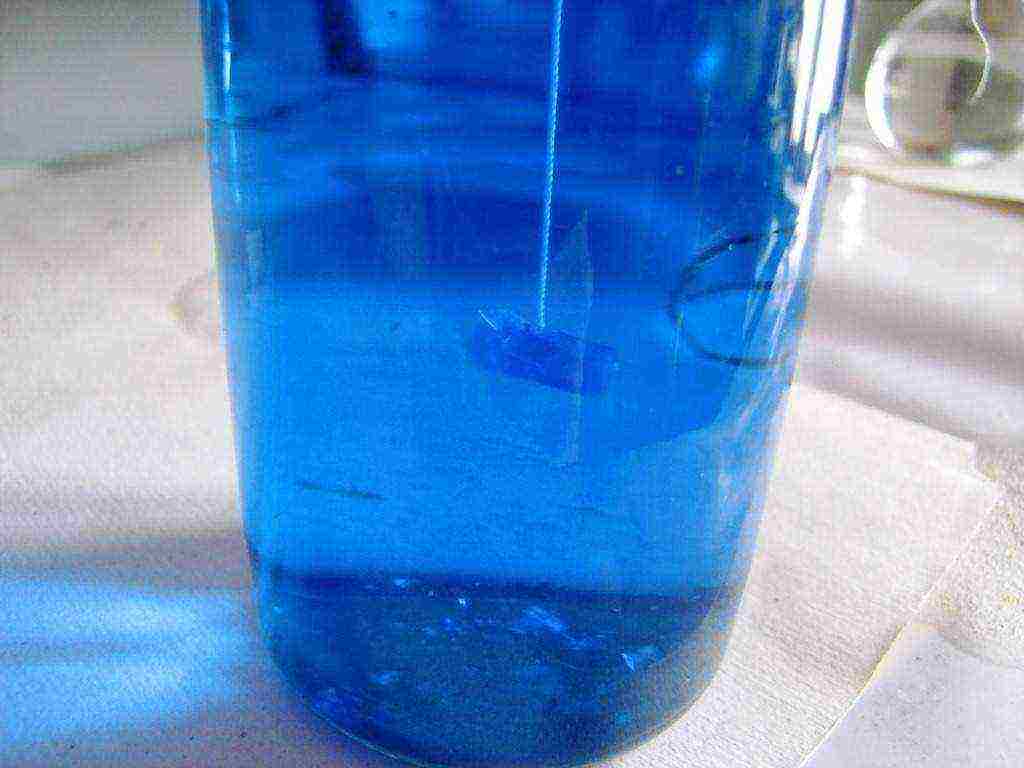
And so the crystal grew in a week. Eighth day.
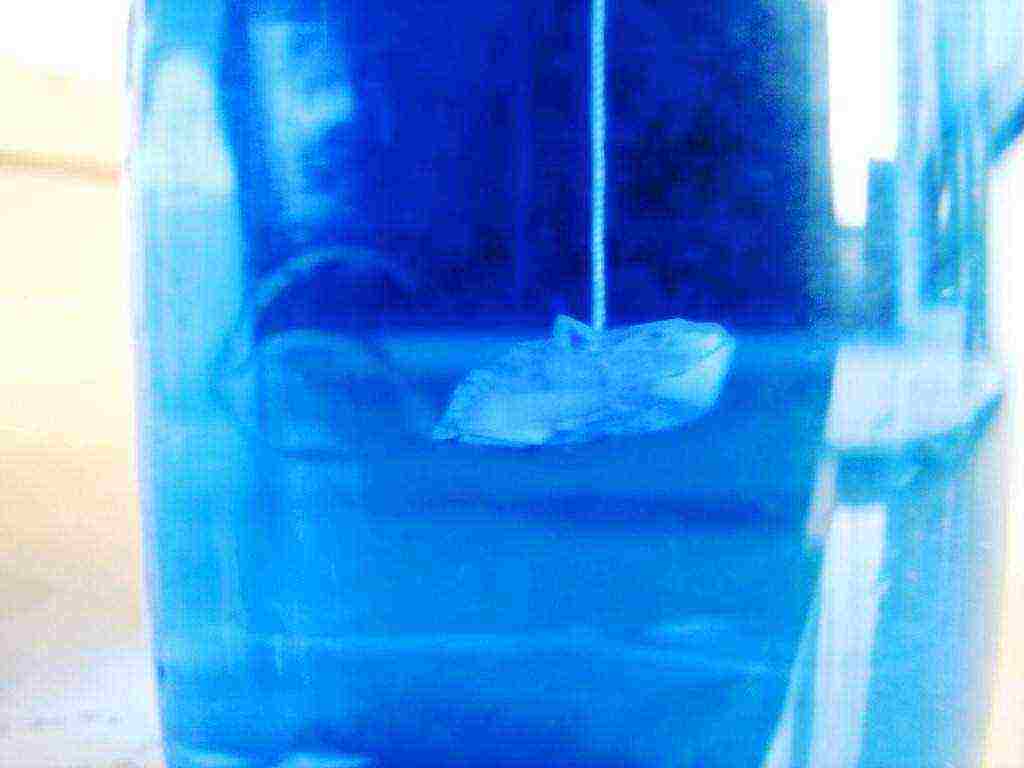
The longer the crystal grows, the larger it becomes.
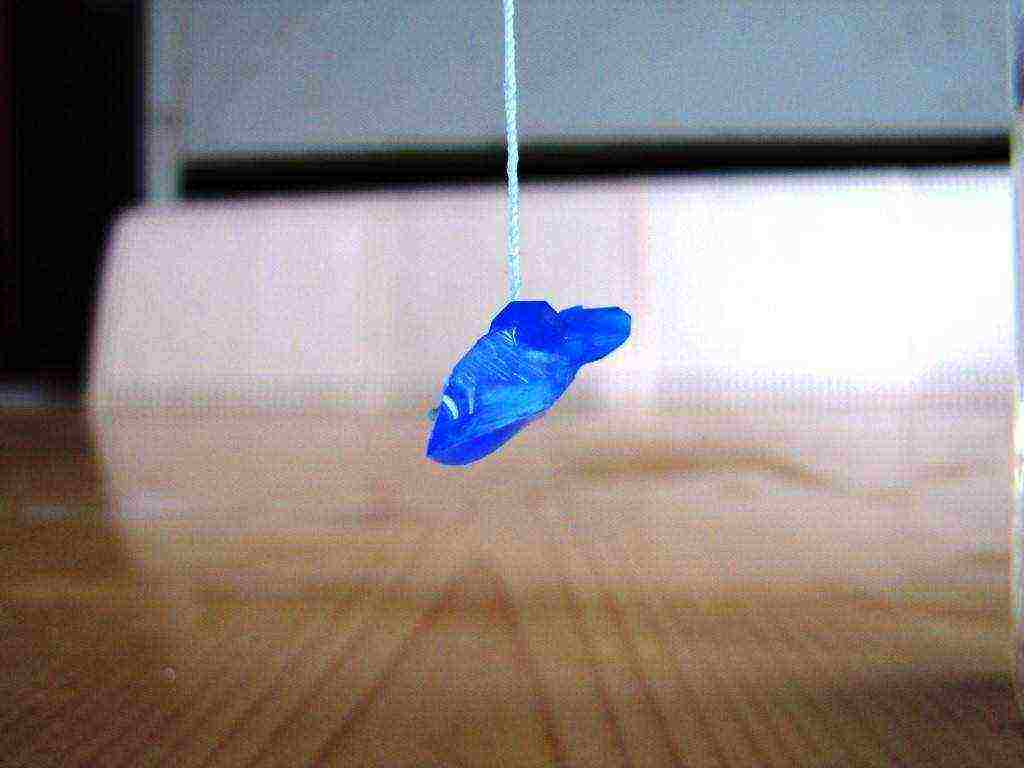
In eight days, the crystal has time to grow by 2 cm.
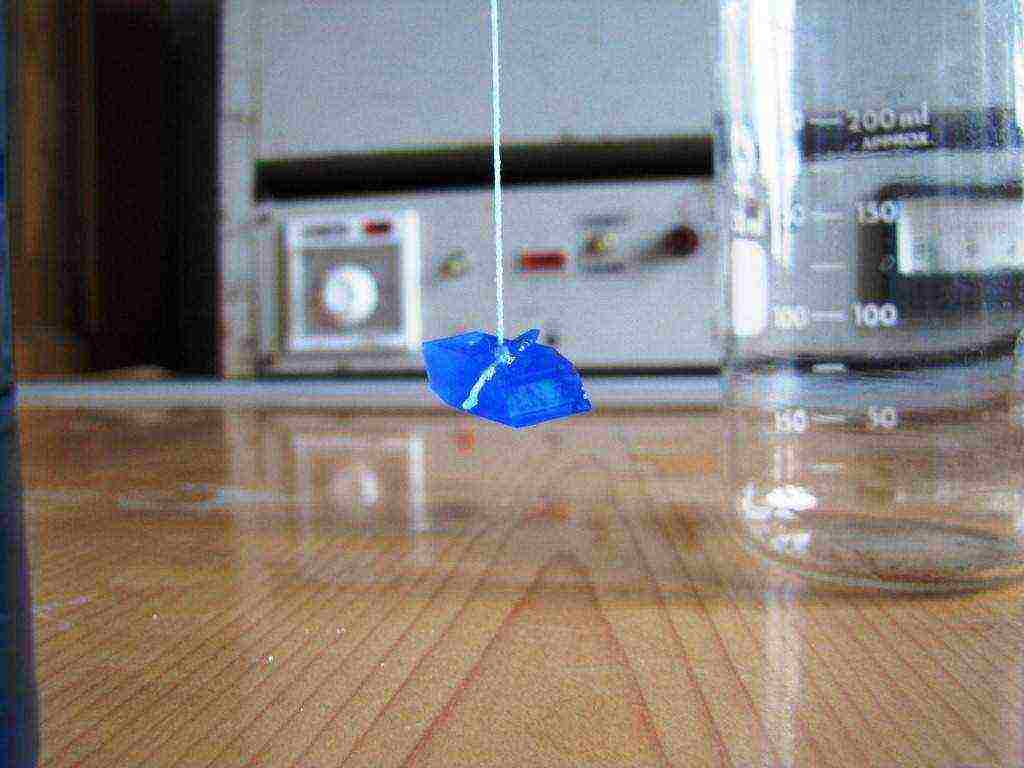
We recommend changing the water in which the crystal grew to a fresh solution, so it will start growing faster.
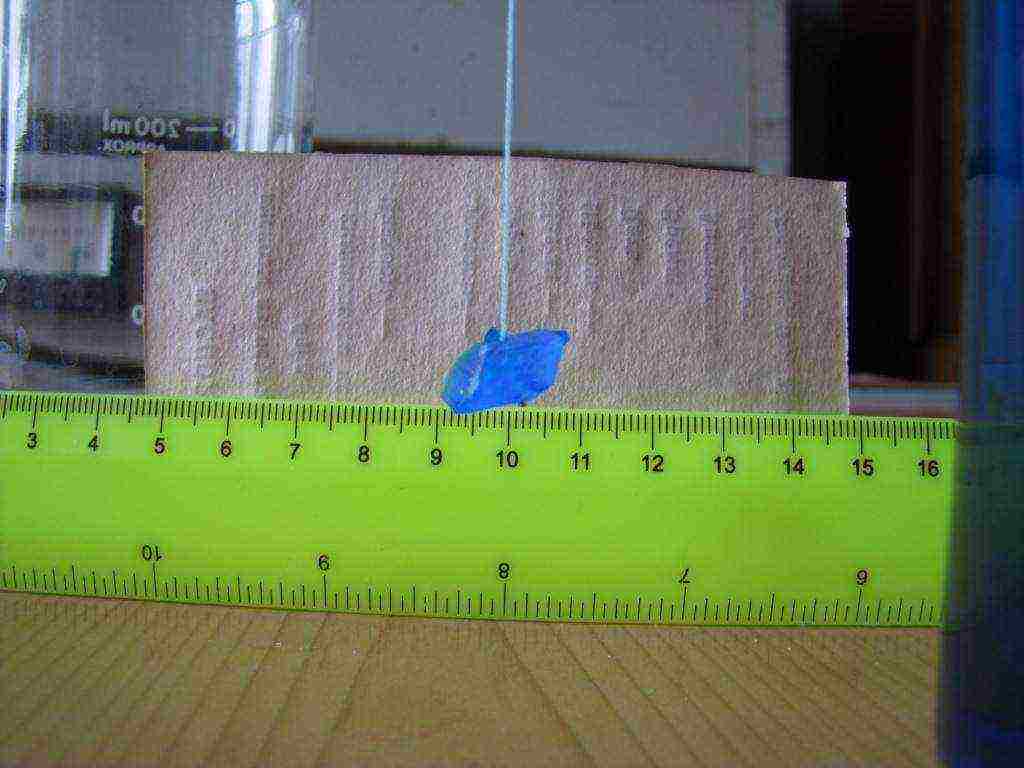
A deep blue is a sign of a good crystal.

This is how the crystal looks on the 11th day of growth.

Change the solution often, do not forget to filter it.
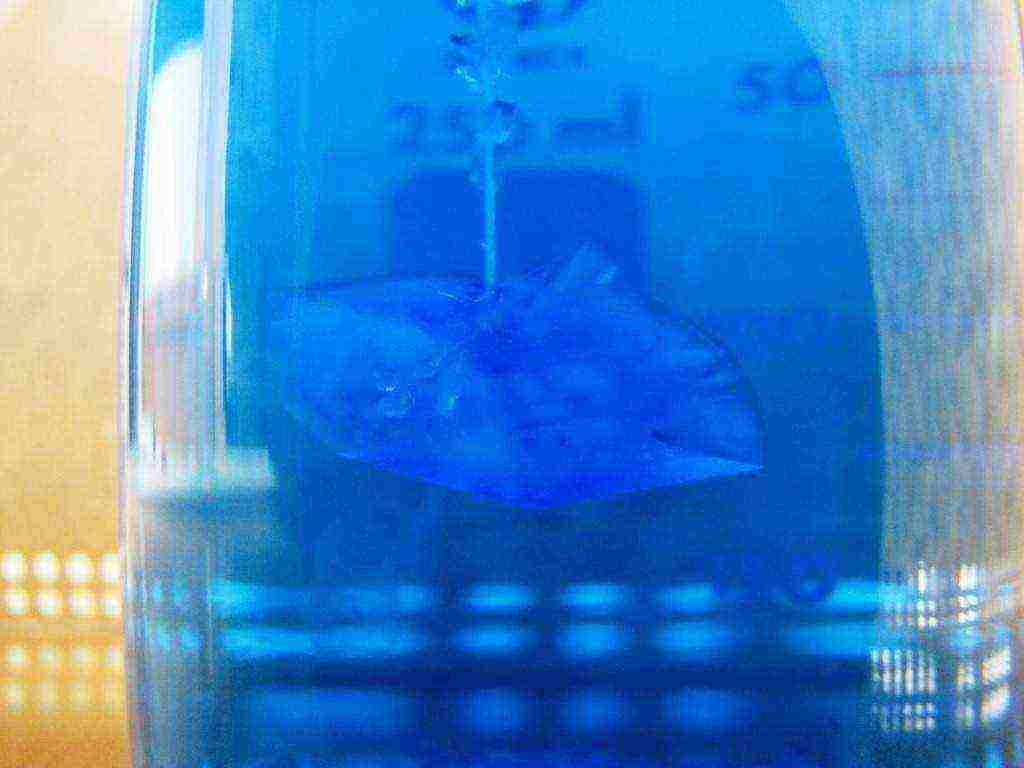
12th day of growth.

In copper sulfate, crystals grow in various shapes, but most often they are treclinic.
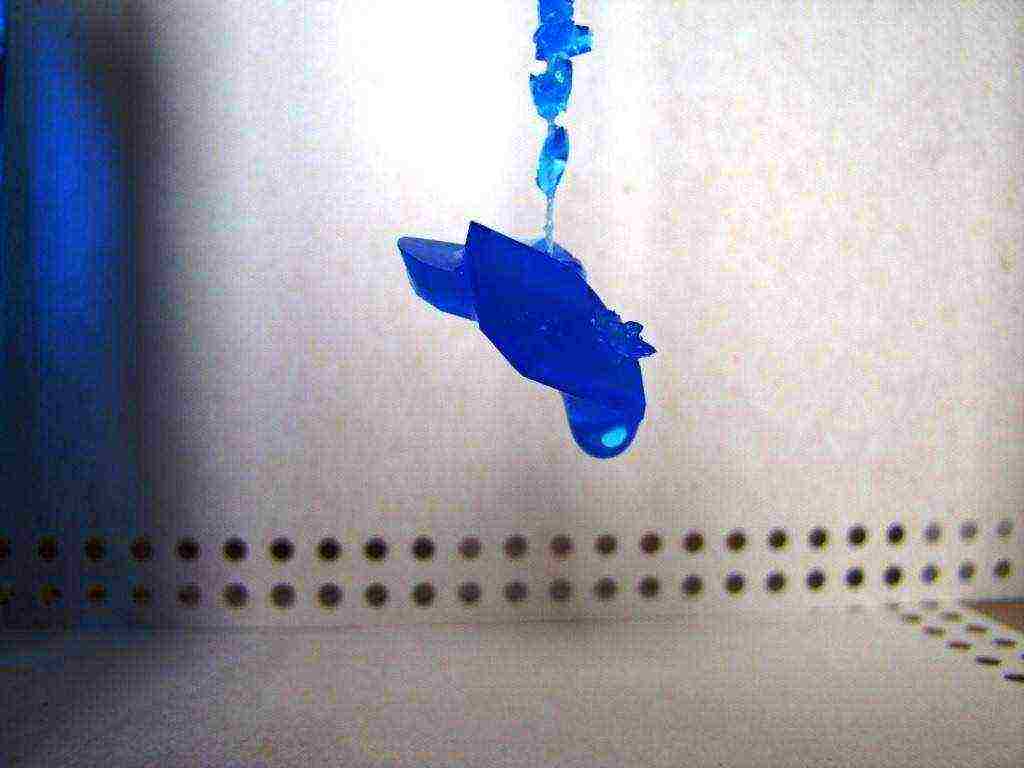
If you choose the evaporation process, then get ready that the crystal will grow for a long time - at least 14 days, during the cooling process it grows faster - only 24 hours, but it can be of an irregular and even unpredictable shape.
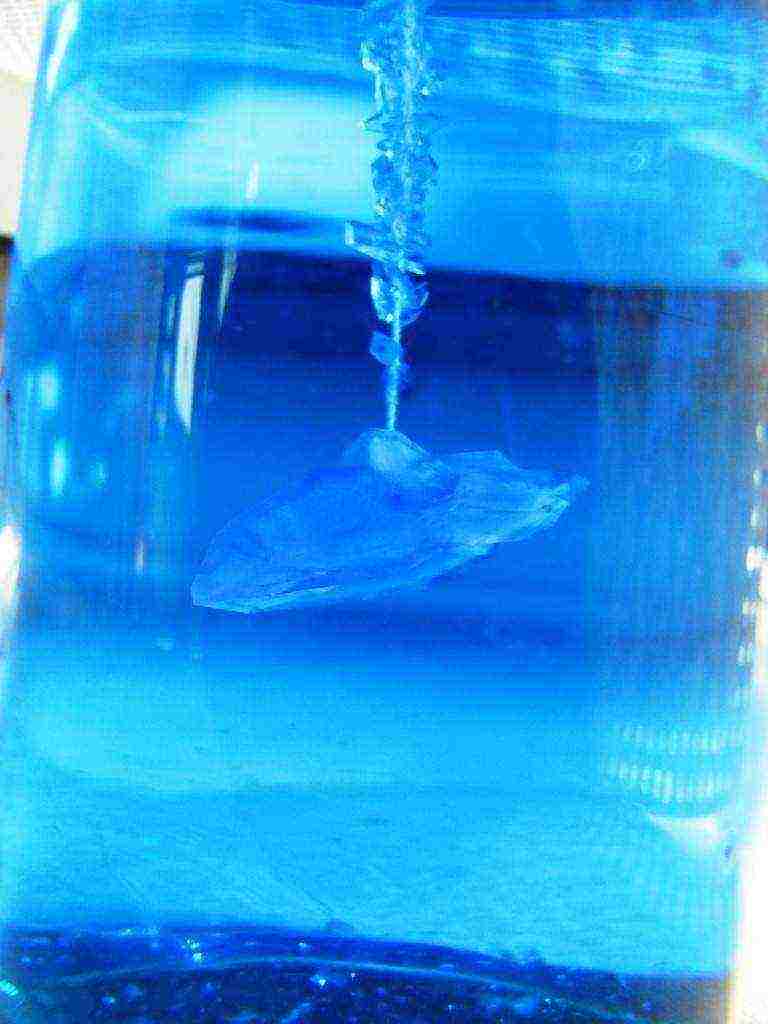
When conducting the experiment, do not use iron objects, as vitriol reacts with iron.
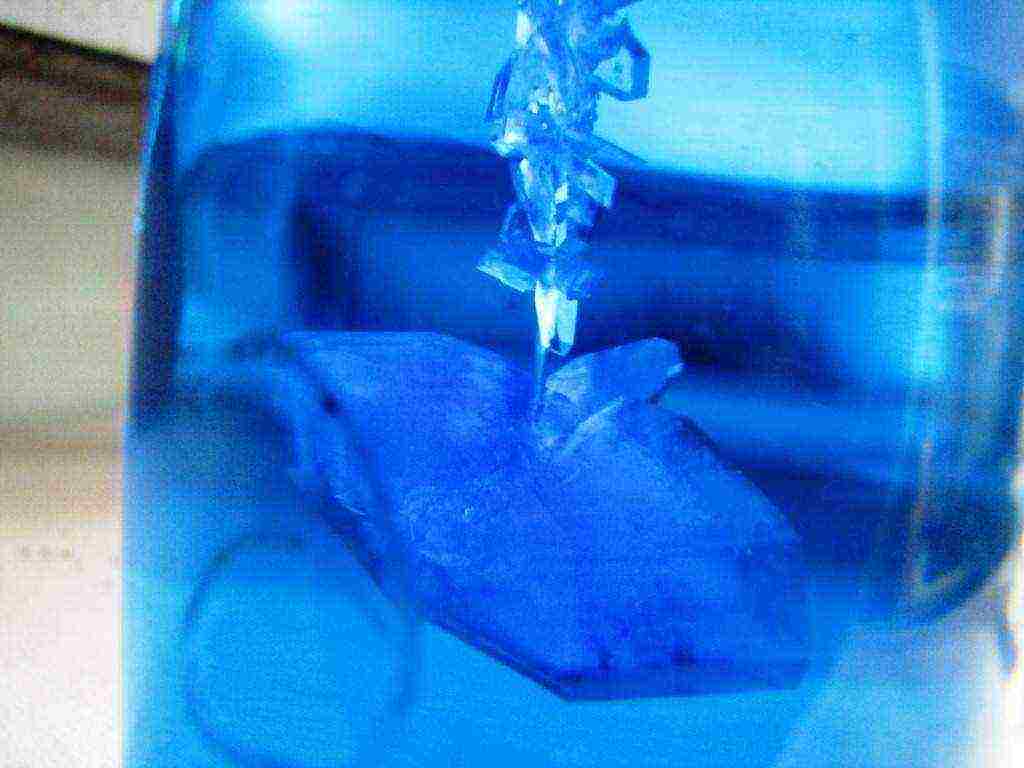
This crystal is already 22 days old.
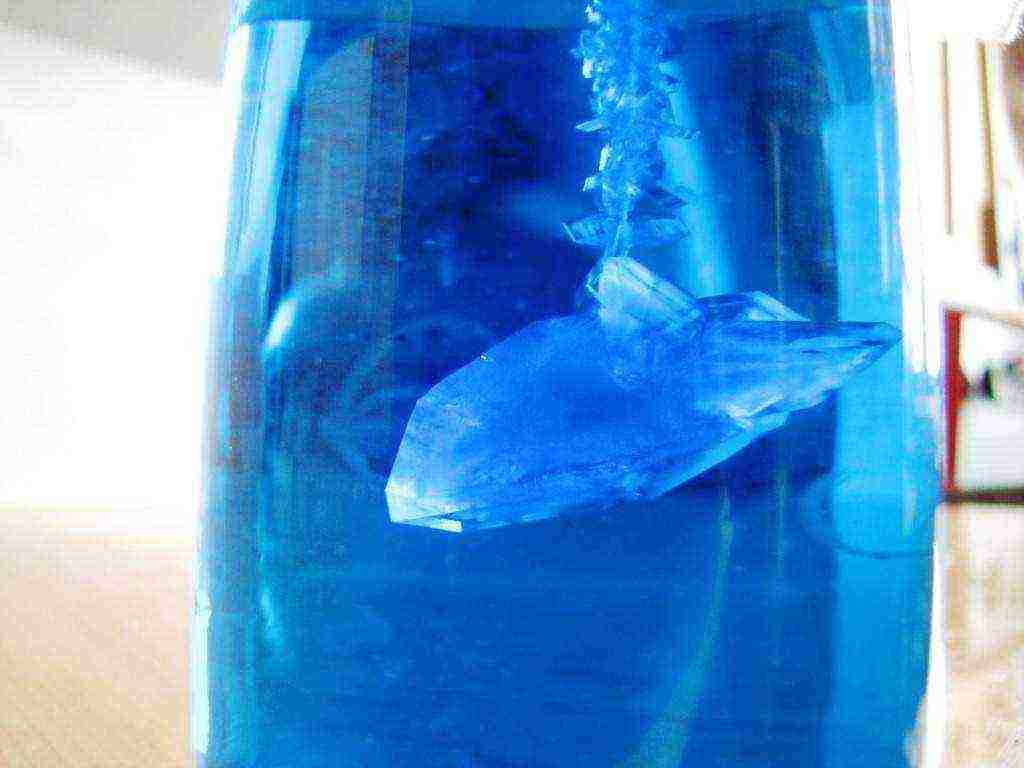
You can even grow crystals for a whole month.
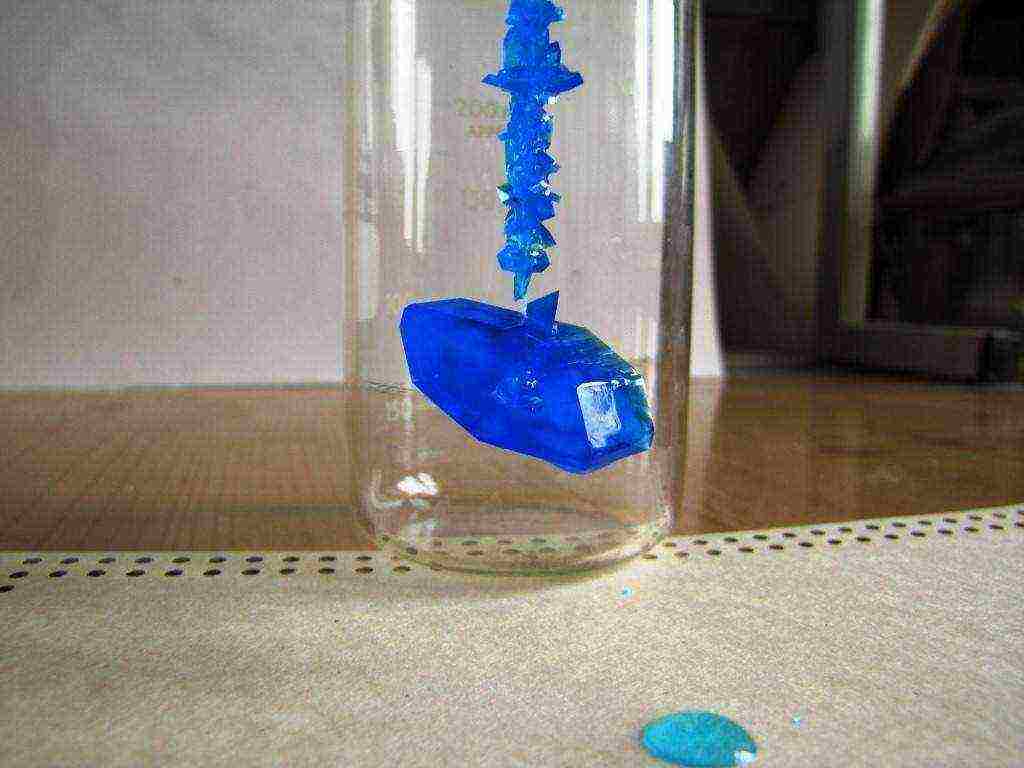
Growing a crystal is a painstaking task, but the result is worth it.

Experiment with children, but be careful with copper sulfate, it is toxic.
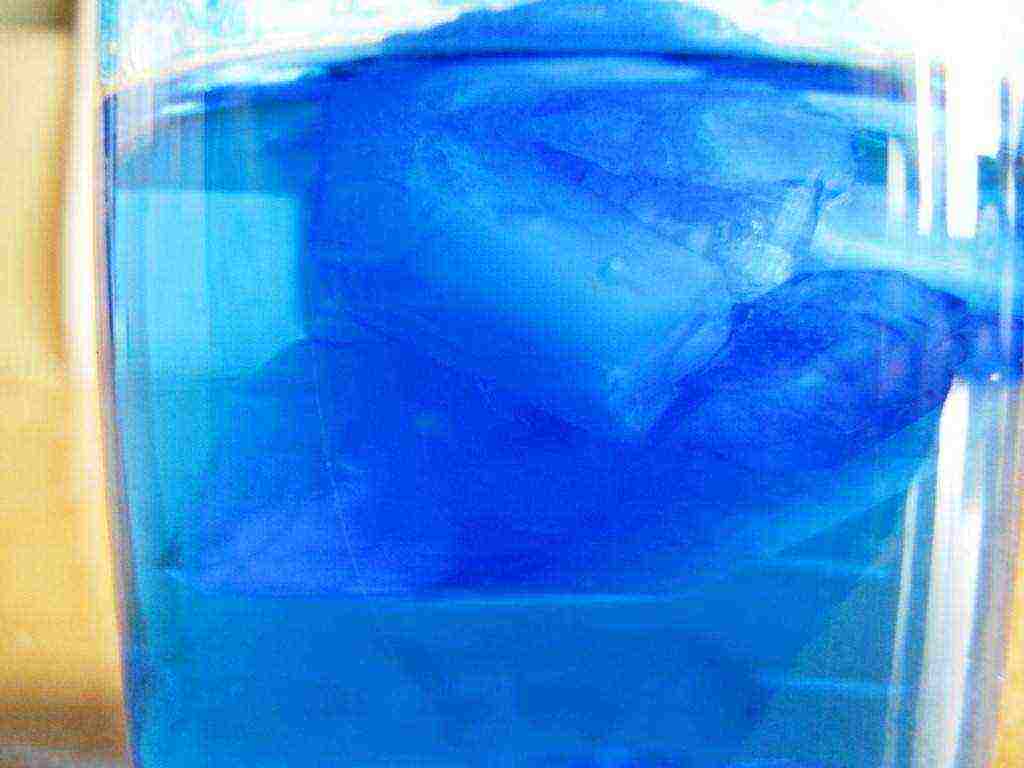
This crystal is 42 days old.
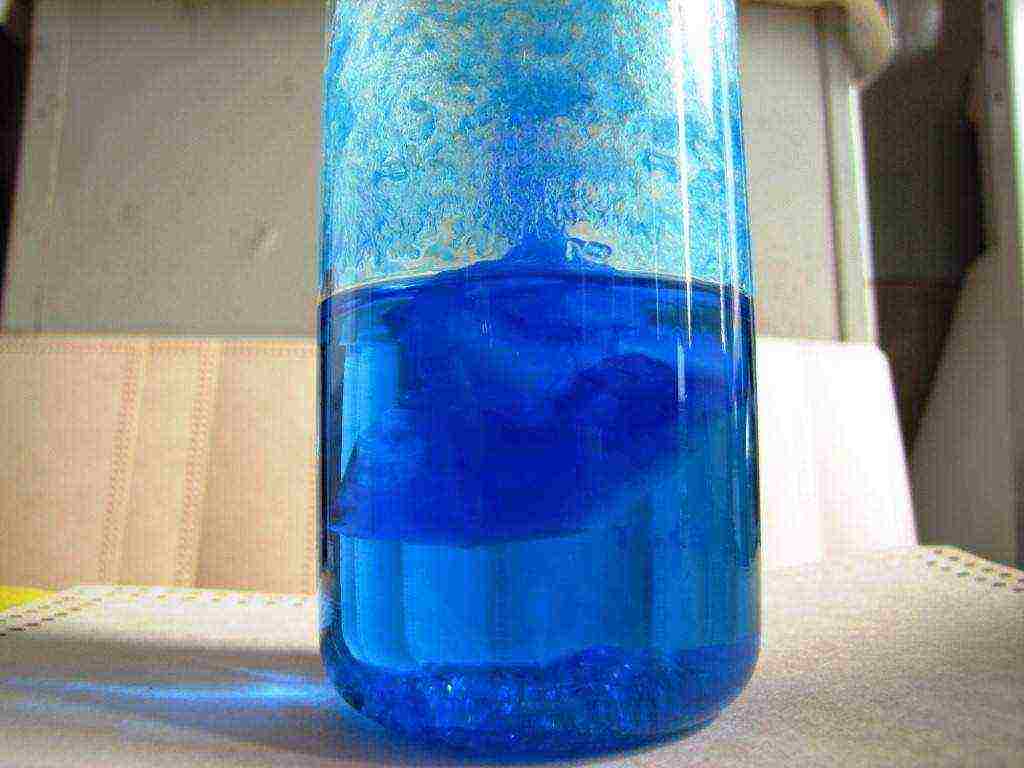
A month and a half is not a period, you can continue to grow until you get bored.
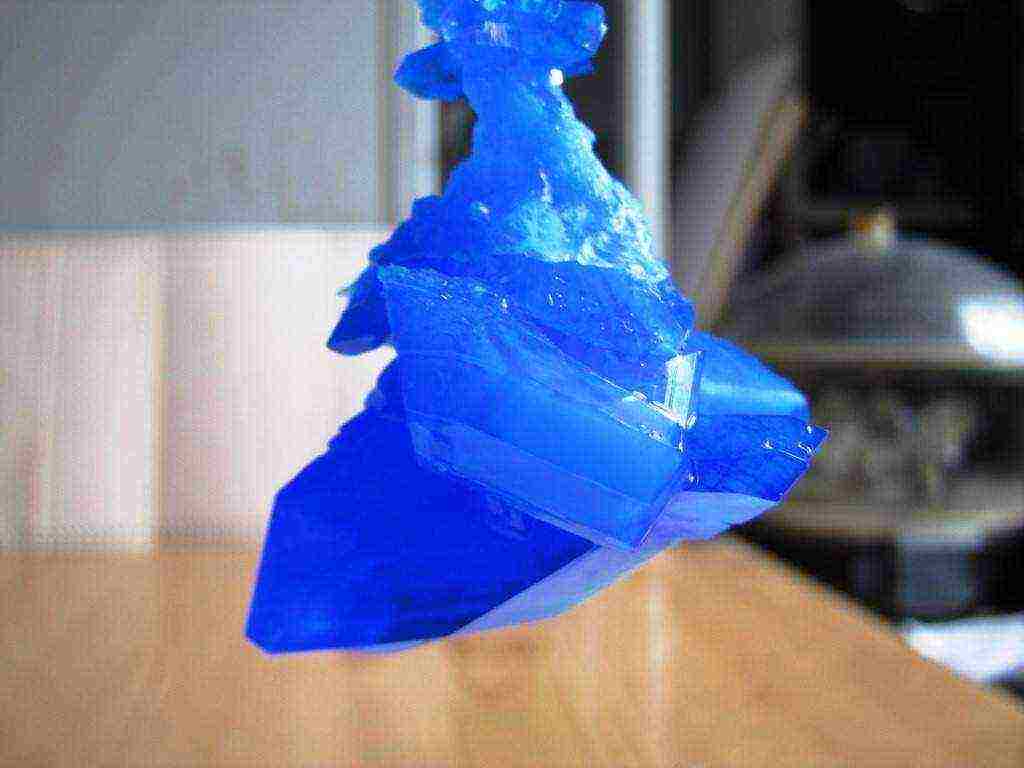
This crystal is 52 days old.

After the crystal has grown, it must be varnished, otherwise it will lose its luster. In 52 days, our crystal has grown 10 cm!
This video shows you how to grow a crystal from regular salt.
This video explains how to grow a copper sulphate crystal.
Content:
Experiments such as growing a crystal with your own hands will help you feel like a jack of all trades - you will learn how to make beautiful home decorations, sweet candies and help your children learn the basics of chemistry.
Crystals use
Such an idea, how to grow a crystal Is a great opportunity to study the chemical properties of different substances. If you have children at home, be sure to challenge them to grow a crystal at home - not without your help, of course. It will be interesting for the children to observe the progress of work, comprehending chemical science in such a fascinating way.
Some experiments will also help you get decorative details for decorating individual compositions - for example, salt crystals can be excellent decorating materials.
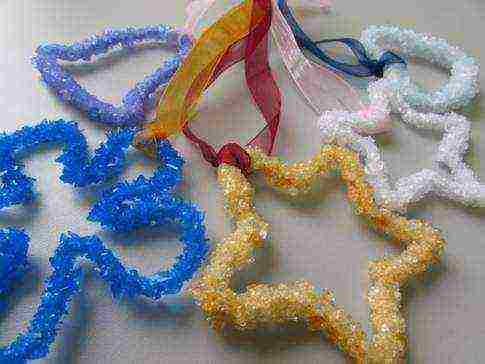
However, it must be remembered that many of the materials used are extremely poisonous - they should not be touched with hands, inhaled vapors. Such substances are unsuitable for use in everyday life - they can only be used for experiments.
Growing crystals can be chosen as a hobby, an exciting activity, because in fact the creator never knows what kind of crystal will turn out in the end.
Types of chemicals
At home, a crystal can be grown from a variety of substances. Some of them require special processing: you can work with them only under certain conditions - at a special temperature, lighting, etc. These include the following materials:
- Mohr's salt;
- blood salt;
- various alum;
- nickel sulfate;
- ammonium nitrate.
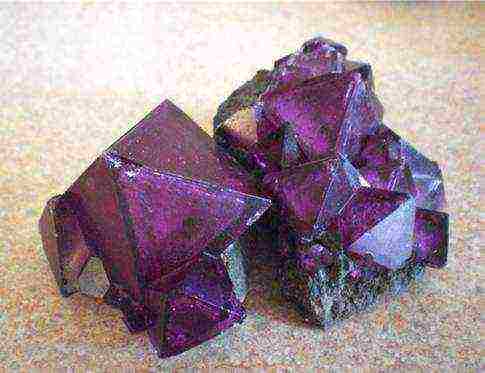
If you are just starting to learn how to grow a crystal at home, it is better to postpone using them.
However, many work mixes, such as table salt, can be found in any home. It is with them that beginners are recommended to start work.
Salt
There is nothing easier than growing salt crystals at home!
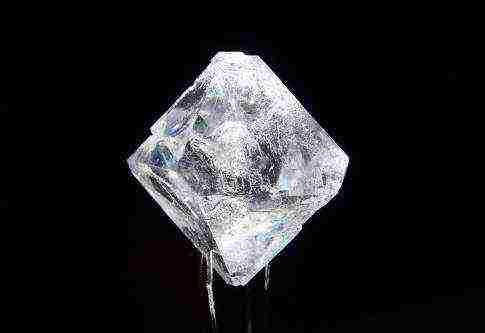
You do not need to use any special accessories or equip a workstation with supernatural conditions to operate this product.
Copper sulfate
Another easy option. Before growing a crystal from copper sulphate, the substance can be bought at an amateur gardener's store - it is sold as a fertilizer.
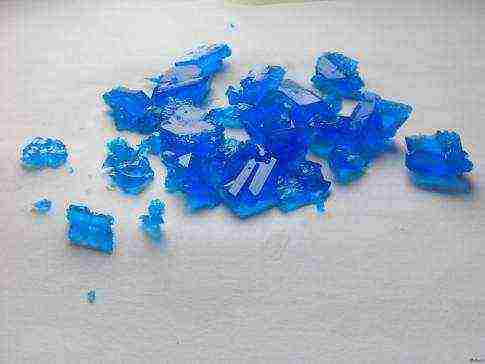
From the master classes below, you will understand that working with vitriol is as easy as growing a crystal from salt. The only difference is that the mixture is an active saturated saline substance, therefore it is undesirable to carry out experiments using running water or any other water - only distilled water is suitable, which you can find in the pharmacy.
Sugar
The only substance that can be eaten after the experiment! Experiments with sugar are completely harmless, so you can safely teach children how to grow a crystal by his example.
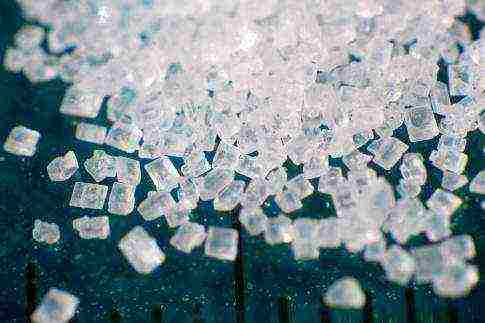
As a result, you should get delicious sugar candies in the form of frosty crystals - an original replacement for cockerels on a stick.
Safety regulations
Despite the fact that novice chemists use mainly familiar solutions, such as salt or sugar, everyone must follow certain precautions - the instructions are presented below.
- Allocate special dishes for the experiments, from which you will not eat in the future. Failure to do so can lead to serious food poisoning.
- Each substance must be stored in a separate, hermetically sealed package with the mandatory signature of the contents on the bottle. Keep substances out of reach of children and pets, in a cool and dark place.
- Use protective clothing and gloves.
- Work with chemicals that emit vapors into the air should be carried out only near powerful hoods.
- If acid gets on the skin, it is imperative to sprinkle the place with a weak alkali (water diluted with baking soda) and vice versa - alkaline solutions can be easily neutralized with an acid like citric acid.

Skills like these come in very handy when working with hazardous chemicals. Over time, you will bring the implementation of this instruction to automaticity and you will not be able to worry when you want to use dangerous mixtures instead of ordinary salt or soda to grow a crystal.
Salt crystals at home
After theoretical advice, you can move on to the part where you will learn how to grow a crystal from salt. Prepare water in unlimited quantities - it is better to use distilled (purified from any additives) so that the substance does not react with any impurities. However, regular running water will do as well.
In addition, you will need a small saucepan, a glass container (jar, glass), silk thread, and a pack of salt.
- Place a saucepan of water over medium heat. Heat the water, but do not bring it to a boil.
- Start adding salt to the water in small portions, stirring constantly. Pour in a new handful each time after completely dissolving the previous one.
- The preparation of the solution ends when the salt has completely ceased to dissolve in water - this means that you have prepared a concentrated mixture.
- Pour the concentrated composition into a transparent glass container and leave to settle for about a day.
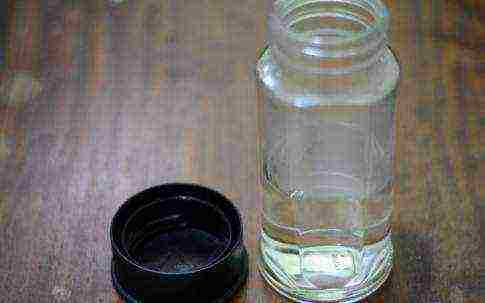
- Free time is necessary for all the smallest, undissolved particles to settle to the bottom. In the photo you can see how the salt sludge is obtained.

- Take a thread or string and tie it around a long thin stick that you can put on the neck of a glass container.
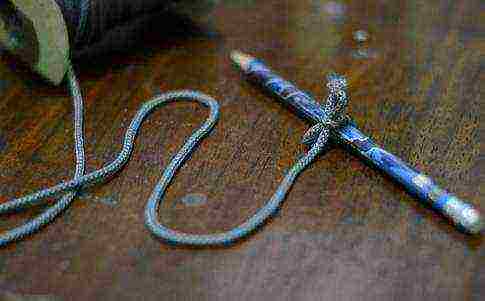
- The length of the lace should be less than the height of the vessel, so cut off the excess.

- Dip the string into the water while suspended so that it does not touch the walls of the can and the sediment at the bottom.
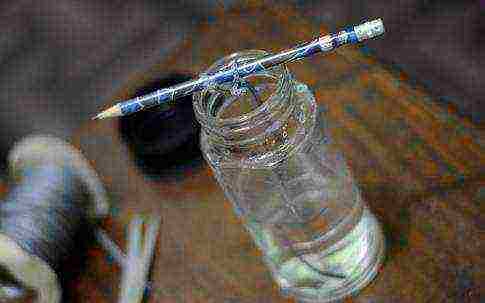
- Leave the experiment in this state for 1-3 weeks.

- After a couple of days, you will notice the growth of small crystals on the thread. The experiment in this case is interesting just by observing how much the crystal grows over a certain period of time.
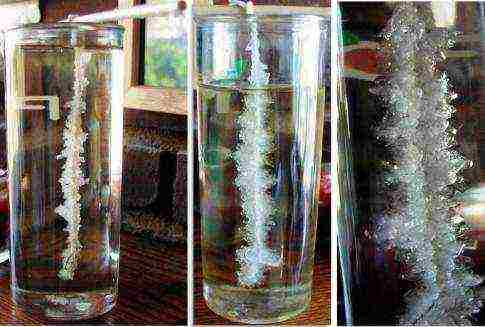
- Instead of using ordinary string, you can dip a large piece of salt suspended on a string into the glass. In this case, the substance will grow around it.
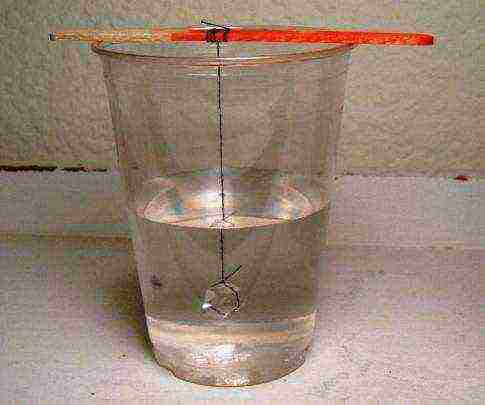
You can grow a crystal of a certain shape or arbitrary. To control the appearance of the substance, apply a thin layer of fat or petroleum jelly on one side of the crystal - you will see that there will be no growth here.
If desired, salt can be replaced with other substances - for example, using the same technology, it is easy to prepare crystals from soda or copper sulfate.
How to grow a crystal from sugar?
If you have set yourself the goal of learning how to grow a crystal from sugar, you will be pleasantly surprised by the result - beautiful sweet lollipops that will delight children and pleasantly surprise adults during tea drinking. An interesting way to use them is to stir tea with them. This gives you both a stirring stick and sugar sweetener.

- Prepare a concentrated sugar solution in the same way as in the experiment with salt - the sugar should completely stop dissolving in warm water. Then pour the hot syrup into a transparent bowl.
- When the solution is ready, prepare the base sticks. Tie one stick to the other in a criss-cross manner so that the first is lowered into the vessel, and the other holds on to its neck.
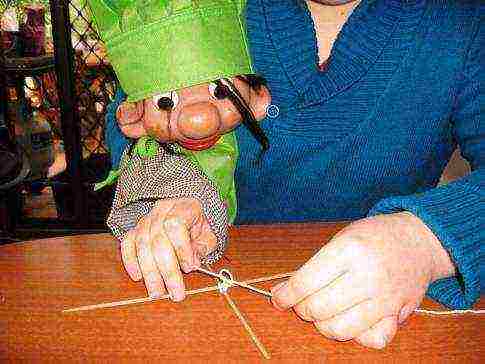
- Dip the stick in the syrup - it shouldn't touch the bottom.

- Leave the structure in a dry and warm place - you will notice in a day how crystals begin to appear in the liquid.
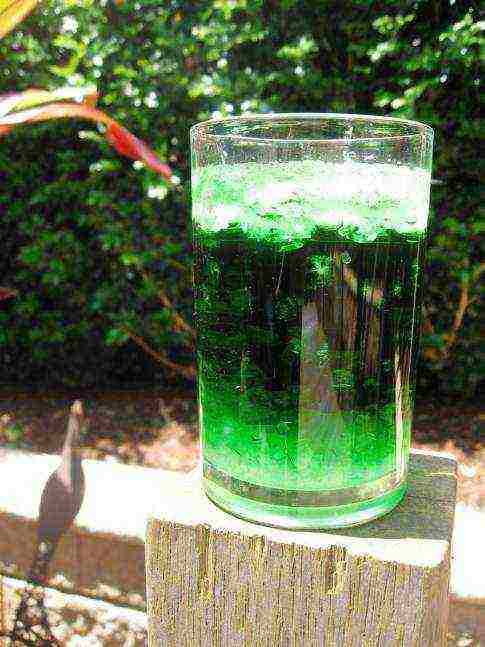
- After about a week, you will have finished sugar skewers. Bon Appetit!

If you want a colored lollipop, add a little food coloring to each jar as you pour the hot syrup.
Such sweets can become a pleasant gift for loved ones for the holidays - such sweet sticks can be supplemented with a present for the New Year or Birthday.
To find out how to grow a crystal from copper sulfate, watch the following video.
